SCHEME OF WORK
WEEK TOPIC
1. Revision of first term work /cultural practices.( meaning, planting operations.)
2. Description of planting operations and post planting operations
3. Harvesting operation and post harvesting operation.
4. Feeds and feed types and identification of feed tools.
5. Farming systems.(Definition ,types advantages and disadvantages )
6. Cropping systems. (Sole cropping, mixed cropping, continuous cropping and taungya system)
7. Cropping systems contd.(Crop rotation principles advantages and disadvantages)
8. Fishery (Definition, Classification with examples.)
9. Description of other types of aquatic organisms.(Crustaceans, Reptiles, Mammals, Mollusca.)
10. (a) Uses of fish and fish products, (b) Methods of fishing and fishing equipment (c) Fish processing and preservation.
11. Revision.
2ND TERM
WEEK 1
LESSON 1
TOPIC: Cultural Practices
CONTENTS: i. Definition and types of cultural practices
ii. Description of pre-planting operations
Definition and types of cultural practices
Cultural practices or operations refer to all the operations carried out on the farm from the beginning of the farming season to the end of that season. Cultural operations can be classified as
• Pre-planting operations
• Planting operations
• Post-planting operations
Description of pre-planting operations
Pre-planting operations are the farming activities carried out before planting is done. These activities are carried out to prepare and make the soil conducive for the crop to be planted.
Pre-planting operations include: selection of the site, clearing, burning, stumping, plotting or layout, tilling or ridging, ploughing, harrowing, nursery and nursery practices.
i. Selection of site: The site selected should suit the purpose of production in term of size, fertility of the soil, topography, accessibility, availability of water

ii. Clearing: The bush on the site is cleared using a cutlass or bulldozer, and fell some big trees
iii. Burning: In the tropics the vegetation is usually disposed by burning. The ash from burnt bush enriches the soil with potash.
iv. Stumping: This involves uprooting the bases of shrubs and trees. It can be done manually, using a cutlass, mattock, or by a bulldozer.
v. Plotting or layout: A new farm is usually laid out into rectangular plots, using the 3, 4, 5 method. A ranging pole and a measuring tape are the essential tools for plotting
vi. Tilling: A small farm is usually cultivated by tilling; using a hoe to break and loosen the soil to the correct depth .This enables air and water to reach the roots. It enables the roots push their way into the soil and absorbs water and mineral salts.
vii. Ploughing: This breaks up the soil, leaving it in large clods .It buries the weeds and loosen the soil, making it possible and easy for crop roots to penetrate and for air and water to reach the roots of crops. This is the first operation in tillage.
viii. Harrowing: This involves breaking up (pulverizing) the soil into smaller clods after the initial ploughing, and in readiness for planting or ridging.
ix. Ridging: Ridges, heaps, or mounds serve the same purpose in crop production. Ridges are made at right angles to the slope , using hoe hoes or a tractor driven mould-board disc ridger
x. Seed selection: Pour the seeds into a container of water. Those seeds that float on top should be discarded while those that stay at the bottom should be planted, they are tested viable.
xi. Nursery practice: Small seeds and fragile planting materials need special care in a nursery beds, baskets, pots, trays, polythene bags or boxes. This allows greater care to be given to them. Seedlings protected in this way are stronger, grow faster and more uniform. The containers should be three –parts good topsoil, two-part compost, and one-part fine river sand, sterilized to kill micro-organisms weeds. The containers are perforated at the bottom to allow excess moisture to drain off in each case. Some of the crops raised in the nursery are oil palm, guava, cocoa, orange, etc.

EVALUATION
1. List the pre-planting operations in their order and explain on any five.
2. What is ploughing?
3. State three advantages of ploughing a piece of land before planting.
4. Why is it necessary to raise seeds in the nursery first?
Assignment
Junior Secondary Agriculture (workbook) book 2 by Anthony Youdeowei et al Chapter 6
Reading Assignment
Junior Secondary Agriculture, book 2 by Anthony Youdeowei et al, Pages 56-65
REFERENCE TEXTS
I Junior Secondary Agriculture for Nigerian Schools by Anthony Youdeowei et al
2 Intensive Agricultural sciences For JSS 1-3 By E.U Okaro
3 Comprehensive Agricultural Science by G.M Nwabuisi et al
TOPIC: Cultural Practices
CONTENTS: i. Definition and types of cultural practices
ii. Description of pre-planting operations
Definition and types of cultural practices
Cultural practices or operations refer to all the operations carried out on the farm from the beginning of the farming season to the end of that season. Cultural operations can be classified as
• Pre-planting operations
• Planting operations
• Post-planting operations
Description of pre-planting operations
Pre-planting operations are the farming activities carried out before planting is done. These activities are carried out to prepare and make the soil conducive for the crop to be planted.
Pre-planting operations include: selection of the site, clearing, burning, stumping, plotting or layout, tilling or ridging, ploughing, harrowing, nursery and nursery practices.
i. Selection of site: The site selected should suit the purpose of production in term of size, fertility of the soil, topography, accessibility, availability of water

ii. Clearing: The bush on the site is cleared using a cutlass or bulldozer, and fell some big trees
iii. Burning: In the tropics the vegetation is usually disposed by burning. The ash from burnt bush enriches the soil with potash.
iv. Stumping: This involves uprooting the bases of shrubs and trees. It can be done manually, using a cutlass, mattock, or by a bulldozer.
v. Plotting or layout: A new farm is usually laid out into rectangular plots, using the 3, 4, 5 method. A ranging pole and a measuring tape are the essential tools for plotting
vi. Tilling: A small farm is usually cultivated by tilling; using a hoe to break and loosen the soil to the correct depth .This enables air and water to reach the roots. It enables the roots push their way into the soil and absorbs water and mineral salts.
vii. Ploughing: This breaks up the soil, leaving it in large clods .It buries the weeds and loosen the soil, making it possible and easy for crop roots to penetrate and for air and water to reach the roots of crops. This is the first operation in tillage.
viii. Harrowing: This involves breaking up (pulverizing) the soil into smaller clods after the initial ploughing, and in readiness for planting or ridging.
ix. Ridging: Ridges, heaps, or mounds serve the same purpose in crop production. Ridges are made at right angles to the slope , using hoe hoes or a tractor driven mould-board disc ridger
x. Seed selection: Pour the seeds into a container of water. Those seeds that float on top should be discarded while those that stay at the bottom should be planted, they are tested viable.
xi. Nursery practice: Small seeds and fragile planting materials need special care in a nursery beds, baskets, pots, trays, polythene bags or boxes. This allows greater care to be given to them. Seedlings protected in this way are stronger, grow faster and more uniform. The containers should be three –parts good topsoil, two-part compost, and one-part fine river sand, sterilized to kill micro-organisms weeds. The containers are perforated at the bottom to allow excess moisture to drain off in each case. Some of the crops raised in the nursery are oil palm, guava, cocoa, orange, etc.

EVALUATION
1. List the pre-planting operations in their order and explain on any five.
2. What is ploughing?
3. State three advantages of ploughing a piece of land before planting.
4. Why is it necessary to raise seeds in the nursery first?
Assignment
Junior Secondary Agriculture (workbook) book 2 by Anthony Youdeowei et al Chapter 6
Reading Assignment
Junior Secondary Agriculture, book 2 by Anthony Youdeowei et al, Pages 56-65
REFERENCE TEXTS
I Junior Secondary Agriculture for Nigerian Schools by Anthony Youdeowei et al
2 Intensive Agricultural sciences For JSS 1-3 By E.U Okaro
3 Comprehensive Agricultural Science by G.M Nwabuisi et al
WEEK 2
LESSON 2
TOPIC: Description of Planting and post-planting operations
CONTENTS: 1. Planting operations: seed treatment, spacing, planting
2. Post-planting operations: thinning, supplying, mulching, manure/fertilizer
application
Planting operations
These are operations associated with the actual planting or sowing of the planting materials. Planting operations include seed treatment, spacing, seed rate, planting date, planting depth, planting.
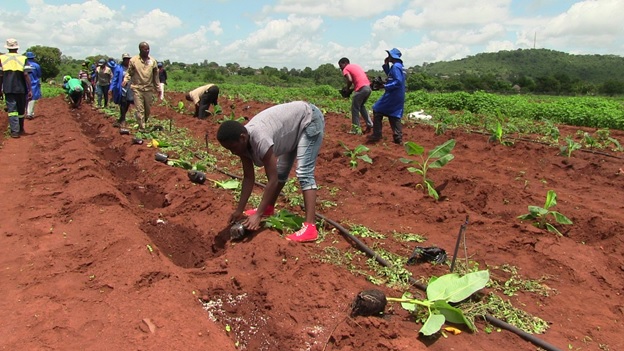
1 Planting date: No definite date can be given for planting a crop because topographic and climatic factors differ from place to place and from time to time. However, planting is done when rain has sufficiently moisture the soil.
2 Seed rate: Seed rate is the amount or quantity of seeds or planting material used on a hectare of land. It is expressed in kilogram per hectare (kg /ha) in the case of seeds and in number of stands per hectare for vegetative propagation
3 Planting distance / spacing: spacing refers to the distance between two plants. It varies from species to species. Crops should be given the correct spacing to avoid too much competition for light, water and nutrients.
4 Planting or sowing depth: The depth of planting required by seeds or seedlings varies with the type of crop>the seed should be covered with rich topsoil, gently pressed down to avoid air pockets.
5 Capping: The practice of using dry grasses or pieces of wood to cover the spot where the yam sett or seed yam is planted either ridge or mound.
6. Transplanting: The following procedure should be adopted in transplanting.
• Water the bed thoroughly 3-4 hours before transplanting.
• Transplant in the evening of a cloudy or rainy day.
• Transplant only strong seedlings, taking them with a ball of earth with a hand trowel.
• Place each seedling with the ball of earth in a planting hole and cover with soil, pressing the ball of earth firmly down.
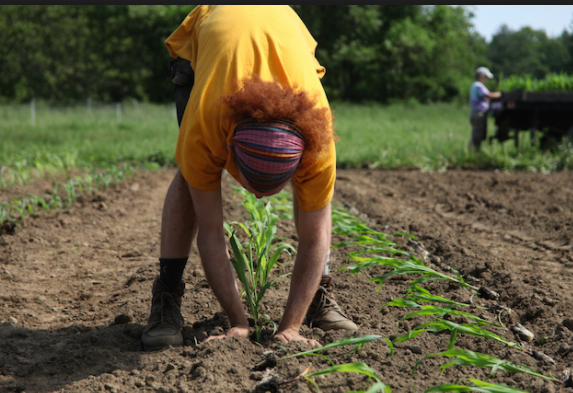
7. Planting methods
• Planting at stake: When planting materials are sown directly in the field on flats, ridges or beds.
• Drilling: Sowing seeds in rows.
• Broadcasting: To scatter over the soil surface.
EVALUATION
Explain the following terms
• Seed rate
• Planting distance
• Capping
State the methods of transplanting seedlings from the nurseries to the field.
LESSON 3
Post-planting operations
These are the operations carried out after planting . They include thinning, supplying, mulching, manure / fertilizer application, weeding, control of pests and diseases, harvesting, processing, storing and marketing.
1. Thinning: This is the removal of extra seedlings from a stand to give room for others to grow. The weakest plants should be carefully pulled up without damaging the remaining ones.
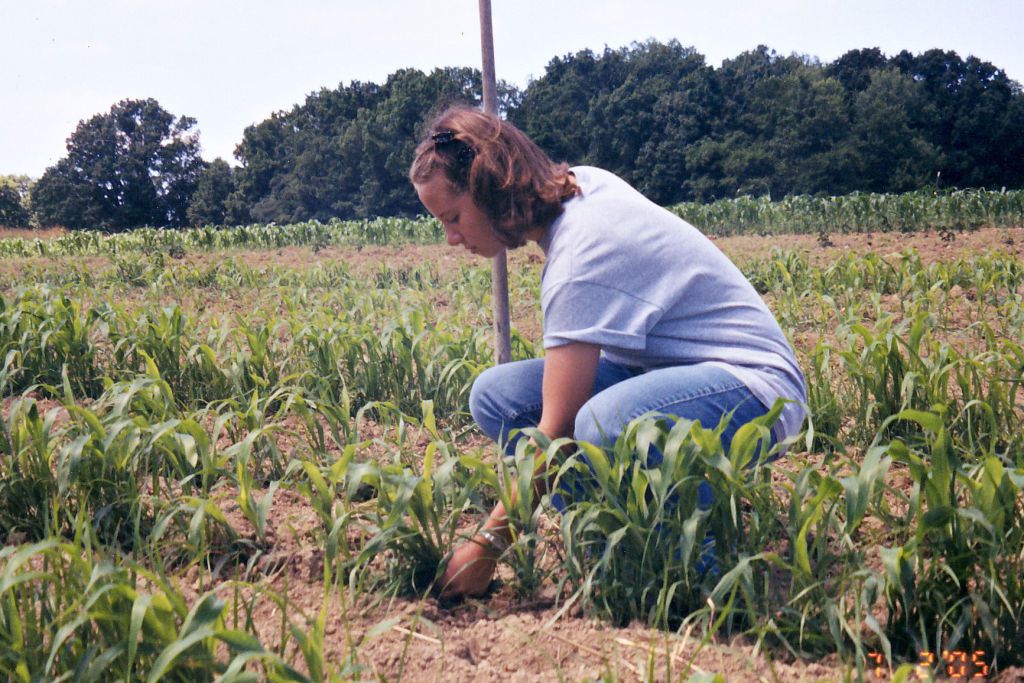
2. Supplying: This is the replacing of seeds that failed to germinate at all because they have lost their viability.
3. Mulching: This is the practice of covering the soil surface with grass, crop residue, straw or sawdust. Mulching helps to prevent growth of weeds, conserve soil moisture, regulate soil temperature and add organic matter to the soil.

4. Fertilizer and manure application: This is the application of inorganic and organic manure to supply plant nutrients for good growth.
5. Weeding: Weeding is the removal of unwanted plants in the farm. Early weeding is recommended as early weed competition is hazardous. Weeds compete with crops for space, light, water and nutrients.
6. Staking: This is supporting some twining and creeping crops such as tomato, yams, pumpkin, etc with sticks to raise them from the ground.

7. Pruning and Trimming: This is the cutting off of dead and dropping branchings.in fruit trees and flowers.
8. Control of pests and diseases: When crops are attacked by pests and diseases, the result is low yield or crop failure. To ensure this it is necessary to prevent and control pests and diseases. This can be achieved by the use of resist ant varieties, good management practices and spraying of pesticides.
EVALUATION
1. State four reasons why weeding is necessary in crop production.
2. List five post-planting operations and explain how two of them are carried out in the farm.
Assignment
Explain the following terms
• Thinning
• Mulching
• Supplying
• Pruning and trimming
Reading Assignment
Junior Secondary Agriculture, book 2 by Anthony Youdeowei, et al; Pages 56-65.
REFERENCE TEXTS
1. Junior Secondary Agriculture for Nigerian Schools by Anthony Youdeowei, et al
2. Intensive Agricultural sciences For JSS 1-3 by E.U Okaro
3. Comprehensive Agricultural Science by G.M Nwabuisi, et al
TOPIC: Description of Planting and post-planting operations
CONTENTS: 1. Planting operations: seed treatment, spacing, planting
2. Post-planting operations: thinning, supplying, mulching, manure/fertilizer
application
Planting operations
These are operations associated with the actual planting or sowing of the planting materials. Planting operations include seed treatment, spacing, seed rate, planting date, planting depth, planting.

1 Planting date: No definite date can be given for planting a crop because topographic and climatic factors differ from place to place and from time to time. However, planting is done when rain has sufficiently moisture the soil.
2 Seed rate: Seed rate is the amount or quantity of seeds or planting material used on a hectare of land. It is expressed in kilogram per hectare (kg /ha) in the case of seeds and in number of stands per hectare for vegetative propagation
3 Planting distance / spacing: spacing refers to the distance between two plants. It varies from species to species. Crops should be given the correct spacing to avoid too much competition for light, water and nutrients.
4 Planting or sowing depth: The depth of planting required by seeds or seedlings varies with the type of crop>the seed should be covered with rich topsoil, gently pressed down to avoid air pockets.
5 Capping: The practice of using dry grasses or pieces of wood to cover the spot where the yam sett or seed yam is planted either ridge or mound.
6. Transplanting: The following procedure should be adopted in transplanting.
• Water the bed thoroughly 3-4 hours before transplanting.
• Transplant in the evening of a cloudy or rainy day.
• Transplant only strong seedlings, taking them with a ball of earth with a hand trowel.
• Place each seedling with the ball of earth in a planting hole and cover with soil, pressing the ball of earth firmly down.

7. Planting methods
• Planting at stake: When planting materials are sown directly in the field on flats, ridges or beds.
• Drilling: Sowing seeds in rows.
• Broadcasting: To scatter over the soil surface.
EVALUATION
Explain the following terms
• Seed rate
• Planting distance
• Capping
State the methods of transplanting seedlings from the nurseries to the field.
LESSON 3
Post-planting operations
These are the operations carried out after planting . They include thinning, supplying, mulching, manure / fertilizer application, weeding, control of pests and diseases, harvesting, processing, storing and marketing.
1. Thinning: This is the removal of extra seedlings from a stand to give room for others to grow. The weakest plants should be carefully pulled up without damaging the remaining ones.

2. Supplying: This is the replacing of seeds that failed to germinate at all because they have lost their viability.
3. Mulching: This is the practice of covering the soil surface with grass, crop residue, straw or sawdust. Mulching helps to prevent growth of weeds, conserve soil moisture, regulate soil temperature and add organic matter to the soil.

4. Fertilizer and manure application: This is the application of inorganic and organic manure to supply plant nutrients for good growth.
5. Weeding: Weeding is the removal of unwanted plants in the farm. Early weeding is recommended as early weed competition is hazardous. Weeds compete with crops for space, light, water and nutrients.
6. Staking: This is supporting some twining and creeping crops such as tomato, yams, pumpkin, etc with sticks to raise them from the ground.

7. Pruning and Trimming: This is the cutting off of dead and dropping branchings.in fruit trees and flowers.
8. Control of pests and diseases: When crops are attacked by pests and diseases, the result is low yield or crop failure. To ensure this it is necessary to prevent and control pests and diseases. This can be achieved by the use of resist ant varieties, good management practices and spraying of pesticides.
EVALUATION
1. State four reasons why weeding is necessary in crop production.
2. List five post-planting operations and explain how two of them are carried out in the farm.
Assignment
Explain the following terms
• Thinning
• Mulching
• Supplying
• Pruning and trimming
Reading Assignment
Junior Secondary Agriculture, book 2 by Anthony Youdeowei, et al; Pages 56-65.
REFERENCE TEXTS
1. Junior Secondary Agriculture for Nigerian Schools by Anthony Youdeowei, et al
2. Intensive Agricultural sciences For JSS 1-3 by E.U Okaro
3. Comprehensive Agricultural Science by G.M Nwabuisi, et al
WEEK 3
LESSON 4
TOPIC: Description of Harvest / post-Harvest Operations
CONTENTS:
1. Description of harvest operations
2. Effects of timely /late harvesting
3. Post-harvesting operations (farm level processing of crops into usable forms and storage)
HARVESTING
Harvesting is the removal and gathering of mature crops for processing and storage.. The sign of maturity differ for different crops. For crops like yam, cocoyam and ground nut, maturity is signified when most of their leaves are turning yellow and drying. The purpose of production also affects the maturity the stage at which the crop is to be used. For example, maize meant to be eaten fresh is generally harvested green while that meant for storage is harvested dried.
• Late harvest: Leads to pest infestation, reduces storage quality, and leads to spoilages, and exposes crops to thieves and predators.
• Timely harvest: Protects crops from pest infestation in the field, protects crops from mould, prevents deterioration and makes the crops store well.
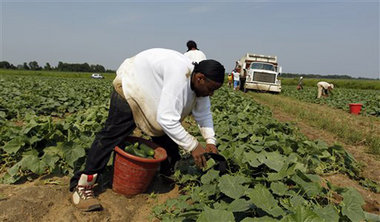
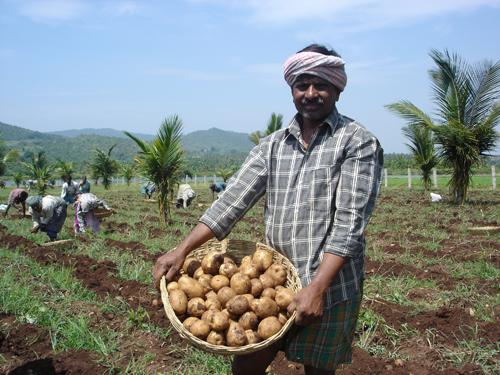

Post- Harvest Operations
Farm level processing: After harvesting, crops needs to be processed so that they can be consumed or stored for future use. Some crops can be processed directly in the farm, and the various activities involved vary from crop to crop. For cereal crops and legumes, the process involves drying, threshing, and winnowing For root and tuber crops, it is cleaning as in cocoyam. It is grinding and frying to garri in cassava.
STORAGE: Storage materials are used for storing agricultural produce until they are sold or used for next season’s operation. They include silos, cribs, rhumbus, beans, fences, compost pits, silage pits, etc.

EVALUATION
Explain the term harvesting.
List five farm storage facilities
Assignment
Distinguish between harvesting and post-harvesting operations
Reading Assignment
Junior Secondary Agriculture, book 2 by Anthony Youdeowei et al; Pages 103-109
REFERENCE TEXTS
1. Junior Secondary Agriculture for Nigerian Schools by Anthony Youdeowei et al
2. Intensive Agricultural sciences For JSS 1-3 By E.U Okaro
3. Comprehensive Agricultural Science by G.M Nwabuisi et al
TOPIC: Description of Harvest / post-Harvest Operations
CONTENTS:
1. Description of harvest operations
2. Effects of timely /late harvesting
3. Post-harvesting operations (farm level processing of crops into usable forms and storage)
HARVESTING
Harvesting is the removal and gathering of mature crops for processing and storage.. The sign of maturity differ for different crops. For crops like yam, cocoyam and ground nut, maturity is signified when most of their leaves are turning yellow and drying. The purpose of production also affects the maturity the stage at which the crop is to be used. For example, maize meant to be eaten fresh is generally harvested green while that meant for storage is harvested dried.
• Late harvest: Leads to pest infestation, reduces storage quality, and leads to spoilages, and exposes crops to thieves and predators.
• Timely harvest: Protects crops from pest infestation in the field, protects crops from mould, prevents deterioration and makes the crops store well.



Post- Harvest Operations
Farm level processing: After harvesting, crops needs to be processed so that they can be consumed or stored for future use. Some crops can be processed directly in the farm, and the various activities involved vary from crop to crop. For cereal crops and legumes, the process involves drying, threshing, and winnowing For root and tuber crops, it is cleaning as in cocoyam. It is grinding and frying to garri in cassava.
STORAGE: Storage materials are used for storing agricultural produce until they are sold or used for next season’s operation. They include silos, cribs, rhumbus, beans, fences, compost pits, silage pits, etc.

EVALUATION
Explain the term harvesting.
List five farm storage facilities
Assignment
Distinguish between harvesting and post-harvesting operations
Reading Assignment
Junior Secondary Agriculture, book 2 by Anthony Youdeowei et al; Pages 103-109
REFERENCE TEXTS
1. Junior Secondary Agriculture for Nigerian Schools by Anthony Youdeowei et al
2. Intensive Agricultural sciences For JSS 1-3 By E.U Okaro
3. Comprehensive Agricultural Science by G.M Nwabuisi et al
WEEK 4
LESSON 5
TOPIC: FEEDS AND TYPE OF FEED-STUFF
Contents: -definition of feed
-Types of feed or feed-stuff
-Identification of feeding equipment
Definition of feed: Feeds are the food given to animals for growth and reproduction. Animals need feed on daily basis for them to grow and reproduce. The feed given to poultry birds are called mash. Thus, there are growers mash for young fowl finisher mash for adult fowl. Layers mash is for fowl that lay eggs.

Type of Feeds or Feed-stuff
Feeds or feed stuff can generally be classified into the following:
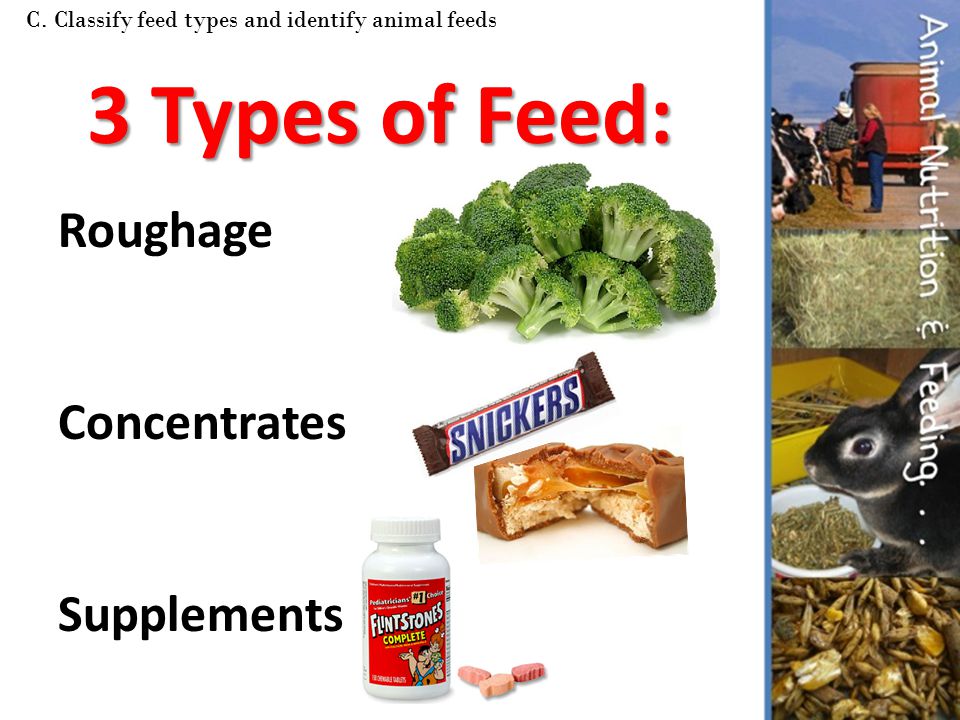
1. Basal or Energy feeds: They are low in fibre and protein content but high in carbohydrates which are highly digestible by animals. Examples include rice, maize, millet, guinea corn, yam and cassava tubers.

2. Concentrates: These are high energy giving feed with low fibre content. They are easily digested. They may be high in energy or proteins. They are normally fed to growing animals and those for reproduction.
Examples of concentrates includes maize , rice, millets, wheat and sorghum. Others are palm kernel cake, cotton seed cake, groundnut cake, bone meal, blood meal, fish meal and oyster shell
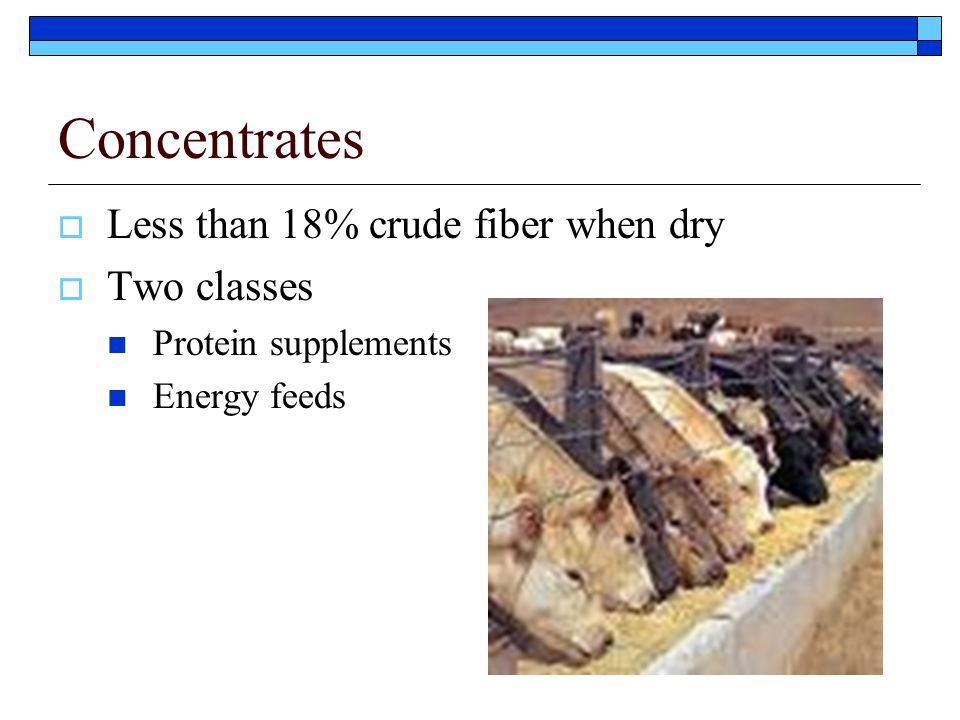
3. Succulents: They are feeds that contain much water. Examples are roots and tubers, silage, vegetables such as water leaf and shokor,

4. Roughages: These feed are high in fibre content and relatively less digestible. They add bulk to the ration given to animals. The nutrient content is low.
Examples of roughages includes silage(fresh grasses and legumes), hay(dry grasses and legumes), straw, chaff. They are fed mostly to ruminants like goat, sheep, and cattle.

5. Supplements: feed supplements are added to the main feed to supply one or more nutrients which are lacking in the main feed. Examples includes Eggshell meal, oyster shell meal, soya bean meal, salt licks, limestone, vitamins
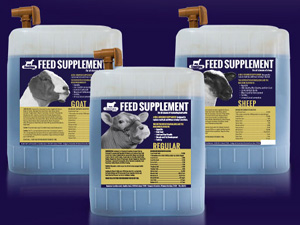
6. Additives: Feed additives include Antibiotics, Amino acids and Hormones.

FEED NUTRIENTS: Many nutrient elements combined in varying forms to make up the various feed nutrients.
TYPES OF FEED NUTRIENTS:
(I) Carbohydrates: They supply energy.
(II) Fat and oil: They supply energy and keeps the body warm.
(III) Proteins: They are needed for growth and repairs of worn-out tissues.
(IV) Minerals: They help to carry out vital body functions.
(V) Vitamins: They help to keep the body healthy
(VI) Water: It is needed in the body fluid
LESSON 6
RATION:
This is the sum total of feed required by an animal for a day. Animals take different amount of food per day depending on the purpose for which the animals are kept. Hence , there are different type of ration.
TYPES OF RATION:
1. Maintenance Ration: The amount of food taken by an animal to keep it alive and it weight constant.
2. Production Ration: It is the amount of feed given to an animal for the purpose of production. The ration is usually higher and richer than production ration. For instance, it is production ration that enables animals to produce meat, milk, eggs or wool.
3. Balanced Ration: It is the ration which contains all the essential nutrients in adequate amount and in the right proportion. A balanced ration should contain carbohydrates, proteins, fat and oil, vitamins, and minerals in adequate amount and in the right proportion .
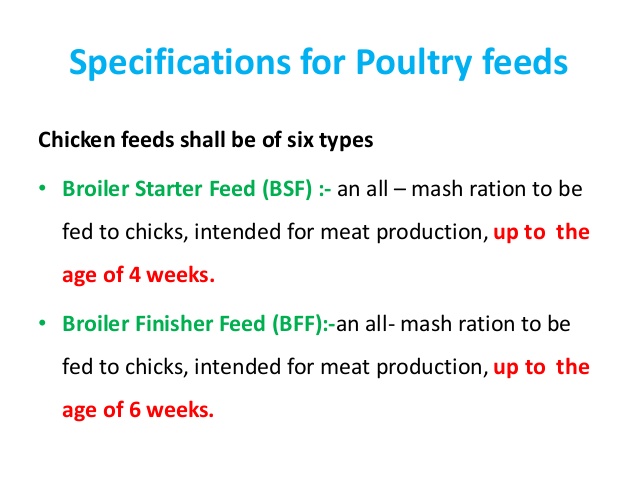
MALNUTRITION: This refers to improper feeding of animals which leads to mal-nutritional diseases. Examples of mal-nutritional diseases in animals includes Rickets, Ketosis, and Marasmus

NUTRIENT ELEMENTS NEEDED BY ANIMALS
About 21 chemical nutrient elements are needed in the body of animals. They are shown in the table below:
Name of element Chemical symbol
1 Carbon -- C
2 Hydrogen-- H
3 Oxygen --O
4 Nitrogen --N
5 Phosphorus-- P
6 Potassium -- K
7 Sulphur --S
8 Calcium --Ca
9 Iodine --I
10 Iron --Fe
11 Magnesium --Mg
12 Sodium-- Na
13 Chlorine --Cl
14 Cobalt --Co
15 Copper --Cu
16 Fluorine --F
17 Manganese-- Mn
18 Zinc-- Zn
19 Molybdenum --Mo
20 Selenium --Se
21 Chromium --Cr
FEED EQUIPMENT: The different equipment used for feeding farm animals are listed below:
I. Feed troughs: Feeds for animals are placed in the troughs for them to eat. Troughs could be wooden, iron or aluminum. Troughs should be cleansed on daily basis.
II. Water troughs: Water for the animals is fetched in this equipment. The trough should as well be cleaned regularly
III. Hay Racks: Forage feeds like hay or silage are placed for ruminant animals.
IV. Shade: Ruminant animals are kept and fed under shade especially during dry season.
V. Trays: Feeds like chick and grower mash are place in the trays for young birds. Trays should be cleansed at all times.

EVALUATION:
1. Defines feed.
2. Give 4 types of feed stuff with two examples.
3. Name the 5 major feed nutrients.
4. Mention the 3 types of ration and explain one of them.
REFERENCE TEXTS: -Essentials of Agricultural sc. By Earnest Chukwudi Anie
-Junior Sec. Agric. For Nigerian Schs. By Athony Youdeowei
-Prescribed Agric. Sc. For JSS. By Omoruyi S.A. et al
-New Intensive Agric. Sc. For UBE. By E.U. Okaro
TOPIC: FEEDS AND TYPE OF FEED-STUFF
Contents: -definition of feed
-Types of feed or feed-stuff
-Identification of feeding equipment
Definition of feed: Feeds are the food given to animals for growth and reproduction. Animals need feed on daily basis for them to grow and reproduce. The feed given to poultry birds are called mash. Thus, there are growers mash for young fowl finisher mash for adult fowl. Layers mash is for fowl that lay eggs.

Type of Feeds or Feed-stuff
Feeds or feed stuff can generally be classified into the following:

1. Basal or Energy feeds: They are low in fibre and protein content but high in carbohydrates which are highly digestible by animals. Examples include rice, maize, millet, guinea corn, yam and cassava tubers.

2. Concentrates: These are high energy giving feed with low fibre content. They are easily digested. They may be high in energy or proteins. They are normally fed to growing animals and those for reproduction.
Examples of concentrates includes maize , rice, millets, wheat and sorghum. Others are palm kernel cake, cotton seed cake, groundnut cake, bone meal, blood meal, fish meal and oyster shell

3. Succulents: They are feeds that contain much water. Examples are roots and tubers, silage, vegetables such as water leaf and shokor,

4. Roughages: These feed are high in fibre content and relatively less digestible. They add bulk to the ration given to animals. The nutrient content is low.
Examples of roughages includes silage(fresh grasses and legumes), hay(dry grasses and legumes), straw, chaff. They are fed mostly to ruminants like goat, sheep, and cattle.

5. Supplements: feed supplements are added to the main feed to supply one or more nutrients which are lacking in the main feed. Examples includes Eggshell meal, oyster shell meal, soya bean meal, salt licks, limestone, vitamins

6. Additives: Feed additives include Antibiotics, Amino acids and Hormones.

FEED NUTRIENTS: Many nutrient elements combined in varying forms to make up the various feed nutrients.
TYPES OF FEED NUTRIENTS:
(I) Carbohydrates: They supply energy.
(II) Fat and oil: They supply energy and keeps the body warm.
(III) Proteins: They are needed for growth and repairs of worn-out tissues.
(IV) Minerals: They help to carry out vital body functions.
(V) Vitamins: They help to keep the body healthy
(VI) Water: It is needed in the body fluid
LESSON 6
RATION:
This is the sum total of feed required by an animal for a day. Animals take different amount of food per day depending on the purpose for which the animals are kept. Hence , there are different type of ration.
TYPES OF RATION:
1. Maintenance Ration: The amount of food taken by an animal to keep it alive and it weight constant.
2. Production Ration: It is the amount of feed given to an animal for the purpose of production. The ration is usually higher and richer than production ration. For instance, it is production ration that enables animals to produce meat, milk, eggs or wool.
3. Balanced Ration: It is the ration which contains all the essential nutrients in adequate amount and in the right proportion. A balanced ration should contain carbohydrates, proteins, fat and oil, vitamins, and minerals in adequate amount and in the right proportion .

MALNUTRITION: This refers to improper feeding of animals which leads to mal-nutritional diseases. Examples of mal-nutritional diseases in animals includes Rickets, Ketosis, and Marasmus

NUTRIENT ELEMENTS NEEDED BY ANIMALS
About 21 chemical nutrient elements are needed in the body of animals. They are shown in the table below:
Name of element Chemical symbol
1 Carbon -- C
2 Hydrogen-- H
3 Oxygen --O
4 Nitrogen --N
5 Phosphorus-- P
6 Potassium -- K
7 Sulphur --S
8 Calcium --Ca
9 Iodine --I
10 Iron --Fe
11 Magnesium --Mg
12 Sodium-- Na
13 Chlorine --Cl
14 Cobalt --Co
15 Copper --Cu
16 Fluorine --F
17 Manganese-- Mn
18 Zinc-- Zn
19 Molybdenum --Mo
20 Selenium --Se
21 Chromium --Cr
FEED EQUIPMENT: The different equipment used for feeding farm animals are listed below:
I. Feed troughs: Feeds for animals are placed in the troughs for them to eat. Troughs could be wooden, iron or aluminum. Troughs should be cleansed on daily basis.
II. Water troughs: Water for the animals is fetched in this equipment. The trough should as well be cleaned regularly
III. Hay Racks: Forage feeds like hay or silage are placed for ruminant animals.
IV. Shade: Ruminant animals are kept and fed under shade especially during dry season.
V. Trays: Feeds like chick and grower mash are place in the trays for young birds. Trays should be cleansed at all times.

EVALUATION:
1. Defines feed.
2. Give 4 types of feed stuff with two examples.
3. Name the 5 major feed nutrients.
4. Mention the 3 types of ration and explain one of them.
REFERENCE TEXTS: -Essentials of Agricultural sc. By Earnest Chukwudi Anie
-Junior Sec. Agric. For Nigerian Schs. By Athony Youdeowei
-Prescribed Agric. Sc. For JSS. By Omoruyi S.A. et al
-New Intensive Agric. Sc. For UBE. By E.U. Okaro
WEEK 5
LESSON 7
TOPIC: FARMING SYSTEM
Contents: - definition and -types of farming systems
- advantages and disadvantages of farming systems.
Definition of Farming systems:
Farming systems refer to the types of technology adopted in farming operations. Any farming system adopted in an area depends on (a) the availability of farmland, (b) the culture of the people, (c) economic factor, (d) geographical factor.

TYPES OF FARMING SYSTEMS: These include Shifting cultivation/Bush fallowing, Land Rotation, Mixed Farming, Ley Farming, and Taungya Farming.
1. Shifting Cultivation/ Bush Fallowing: It is a system whereby a farmer having farmed on a piece of land leaves it for another place . The land is therefore left to rest(fallow) for few years. During this period, the farmer moves or shift to a new place for farming and allows the former place to be covered with bush. After two to four years he returns back to the former place to cultivate the land. This time , the land has regained the lost nutrients.
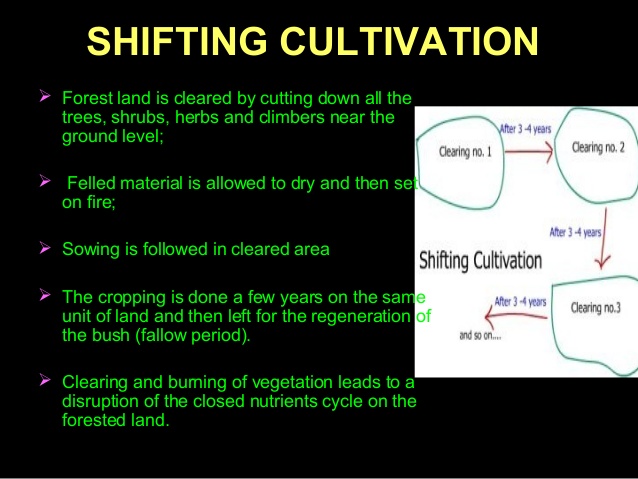
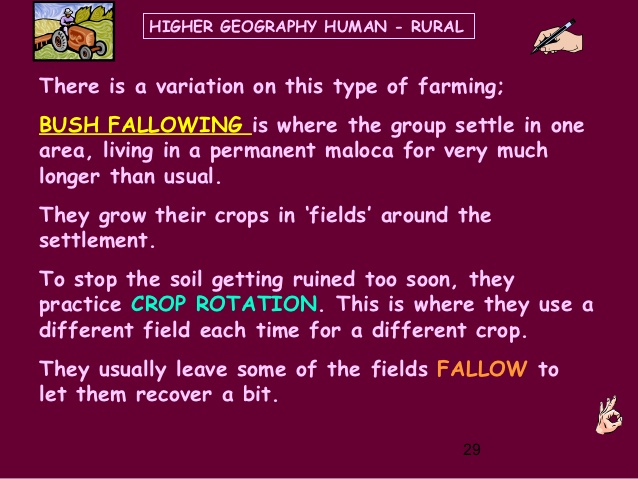
Advantages:
a. It is simple and cheap to practice
b. It prevents the built up of pests and diseases
c. It allows the land to regain its lost nutrients in natural form.
d. The plant caver helps to check erosion.
Disadvantages:
a. Natural forest are often destroyed.
b. It is a slow process of maintaining soil fertility
c. The fallow period may not be enough for the soil to recover its lost nutrients
2. Land Rotation: It is a system whereby a farmland is divided into portions or plots. The farmer cultivates one plot at a time and continues with the others in a definite order until all the plots are completely covered. He then starts all over again. The advantages and disadvantages are similar to that of bush fallowing.

Advantages:
a. the legume crop included in the rotation, helps to add nitrogen to the soil
b. it helps to check erosion
c. pests and diseases attack is reduce
d. different crops are produced in a piece of land.
Disadvantages:
a. soil nutrients is gradually depleted.
b. It requires scientific knowledge
3. Mixed Farming: It is a system whereby a farmer cultivates crops and rear animals on the same farmland. A portion of land is used for crop e.g maize production and a separate portion is used for keeping animals like fowl.

Advantages
a. Food is provided from both crops and animals
b. Income is realized from both crops and animals
c. the crops in the farmland can be used to feed the animals.
d. The manure (droppings or dung) is a source of organic fertilizer for the crops
e. Some of the large animals can be used to work in the farm
f. When there is crops failure, the farmer gains from the animals and vis-visa.
Disadvantages
a. The farmer attention is divided which could lead low production .
b. It requires large capital
c. Much labour and effort is needed
d. Animals could eat up the crops
LESSON 8
4. Ley Farming : It is a system of farming which involves the planting of forage crops and food crops in alternation. The forage crops may include grasses and legumes and crops like maize , rice, cowpea.
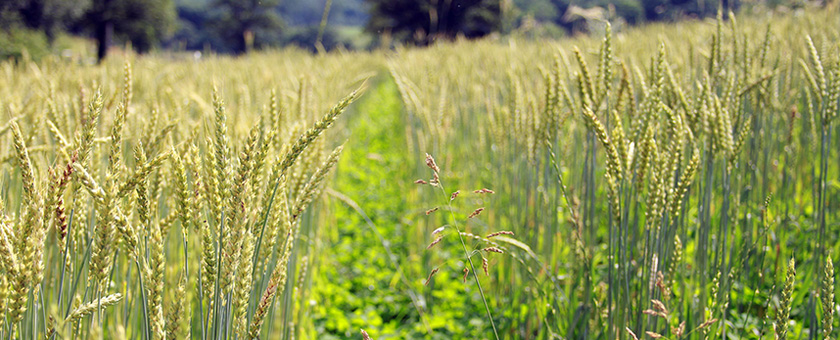
Advantages: the only advantage is that the farmer has forages to feed his animals and at the same time harvest the food crops from his farm.
Disadvantage: the system requires a lot of skills.
5. TaungyaFarming: It involves the planting of food crops along side economic trees in government reserve areas(G.R.A) in the rural areas. When the farmers crops are harvested, the economic trees e.g Obeche, Mahogany or Afara are left on the soil for the government.
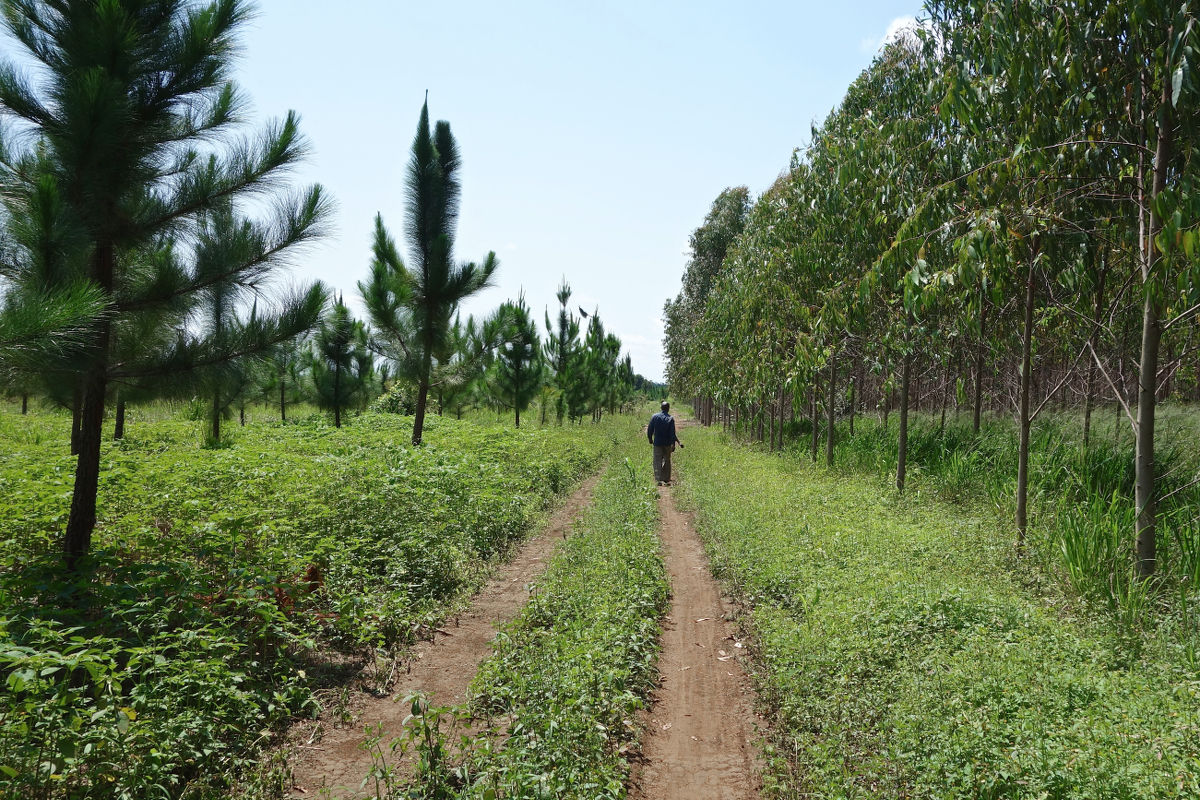
Advantages:
a it provides income to the government when the trees are fell and sold.
b the land is always protected against erosion.
c unwanted forest can be replaced by desirable tree species.
Disadvantages:
a. it leads to the destruction of natural forest
b. the system does not allowed the cultivation of permanent crops.
c. at times the economic trees die off as a result of being neglected by the farmers.
PASTORAL FARMING: It is a system of farming in which a farmer keeps only livestock like cattle, sheep and goats. The two types of pastoral farming are Ranching and Nomadic herding.
(i) RANCHING: The animals are kept in a fenced place where feed and water are supply to them.

Advantages:
a. There is low incidence of pests and diseases
b. There is production of high quality animals
a. It is expensive to practice
b. There is the risk of total loss of animals if they attack by diseases.
(ii) NOMADIC HERDING: It involves the movement of the herdsman with his animals from place to place in search of green pasture and water. This system is commonly practiced by the Fulani of Nigeria.
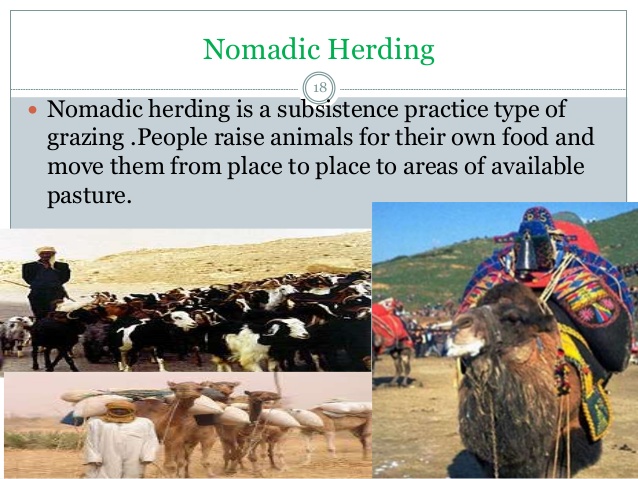
Advantages:
a. There is no cost of feed for the animals.
b. Less labour is required as one man can cater for a large number of animals.
Disadvantages:
a. There is irregular supply of feed and water to the animal.
b. Animals are exposed to insect pests and diseases.
c. The animals and herdsmen are exposed to dangerous animals
d. The animals could be killed by moving vehicles.
EVALUATION:
1. Name 4 types of farming system
2. State 3 advantages and 2 disadvantages of mixed farming system.
3. Write 3 differences between Ley farming and Taungya farming systems.
REFERENCE TEXTS: -Essentials of Agricultural sc. By Earnest ChukwudiAnie
-Junior Sec. Agric. For Nigerian Schs. By Athony Youdeowei
-Prescribed Agric. Sc. For JSS. By Omoruyi S.A. et al
-New Intensive Agric.Sc.For UBE. By E.U. Okaro
TOPIC: FARMING SYSTEM
Contents: - definition and -types of farming systems
- advantages and disadvantages of farming systems.
Definition of Farming systems:
Farming systems refer to the types of technology adopted in farming operations. Any farming system adopted in an area depends on (a) the availability of farmland, (b) the culture of the people, (c) economic factor, (d) geographical factor.

TYPES OF FARMING SYSTEMS: These include Shifting cultivation/Bush fallowing, Land Rotation, Mixed Farming, Ley Farming, and Taungya Farming.
1. Shifting Cultivation/ Bush Fallowing: It is a system whereby a farmer having farmed on a piece of land leaves it for another place . The land is therefore left to rest(fallow) for few years. During this period, the farmer moves or shift to a new place for farming and allows the former place to be covered with bush. After two to four years he returns back to the former place to cultivate the land. This time , the land has regained the lost nutrients.


Advantages:
a. It is simple and cheap to practice
b. It prevents the built up of pests and diseases
c. It allows the land to regain its lost nutrients in natural form.
d. The plant caver helps to check erosion.
Disadvantages:
a. Natural forest are often destroyed.
b. It is a slow process of maintaining soil fertility
c. The fallow period may not be enough for the soil to recover its lost nutrients
2. Land Rotation: It is a system whereby a farmland is divided into portions or plots. The farmer cultivates one plot at a time and continues with the others in a definite order until all the plots are completely covered. He then starts all over again. The advantages and disadvantages are similar to that of bush fallowing.

Advantages:
a. the legume crop included in the rotation, helps to add nitrogen to the soil
b. it helps to check erosion
c. pests and diseases attack is reduce
d. different crops are produced in a piece of land.
Disadvantages:
a. soil nutrients is gradually depleted.
b. It requires scientific knowledge
3. Mixed Farming: It is a system whereby a farmer cultivates crops and rear animals on the same farmland. A portion of land is used for crop e.g maize production and a separate portion is used for keeping animals like fowl.

Advantages
a. Food is provided from both crops and animals
b. Income is realized from both crops and animals
c. the crops in the farmland can be used to feed the animals.
d. The manure (droppings or dung) is a source of organic fertilizer for the crops
e. Some of the large animals can be used to work in the farm
f. When there is crops failure, the farmer gains from the animals and vis-visa.
Disadvantages
a. The farmer attention is divided which could lead low production .
b. It requires large capital
c. Much labour and effort is needed
d. Animals could eat up the crops
LESSON 8
4. Ley Farming : It is a system of farming which involves the planting of forage crops and food crops in alternation. The forage crops may include grasses and legumes and crops like maize , rice, cowpea.

Advantages: the only advantage is that the farmer has forages to feed his animals and at the same time harvest the food crops from his farm.
Disadvantage: the system requires a lot of skills.
5. TaungyaFarming: It involves the planting of food crops along side economic trees in government reserve areas(G.R.A) in the rural areas. When the farmers crops are harvested, the economic trees e.g Obeche, Mahogany or Afara are left on the soil for the government.

Advantages:
a it provides income to the government when the trees are fell and sold.
b the land is always protected against erosion.
c unwanted forest can be replaced by desirable tree species.
Disadvantages:
a. it leads to the destruction of natural forest
b. the system does not allowed the cultivation of permanent crops.
c. at times the economic trees die off as a result of being neglected by the farmers.
PASTORAL FARMING: It is a system of farming in which a farmer keeps only livestock like cattle, sheep and goats. The two types of pastoral farming are Ranching and Nomadic herding.
(i) RANCHING: The animals are kept in a fenced place where feed and water are supply to them.

Advantages:
a. There is low incidence of pests and diseases
b. There is production of high quality animals
a. It is expensive to practice
b. There is the risk of total loss of animals if they attack by diseases.
(ii) NOMADIC HERDING: It involves the movement of the herdsman with his animals from place to place in search of green pasture and water. This system is commonly practiced by the Fulani of Nigeria.

Advantages:
a. There is no cost of feed for the animals.
b. Less labour is required as one man can cater for a large number of animals.
Disadvantages:
a. There is irregular supply of feed and water to the animal.
b. Animals are exposed to insect pests and diseases.
c. The animals and herdsmen are exposed to dangerous animals
d. The animals could be killed by moving vehicles.
EVALUATION:
1. Name 4 types of farming system
2. State 3 advantages and 2 disadvantages of mixed farming system.
3. Write 3 differences between Ley farming and Taungya farming systems.
REFERENCE TEXTS: -Essentials of Agricultural sc. By Earnest ChukwudiAnie
-Junior Sec. Agric. For Nigerian Schs. By Athony Youdeowei
-Prescribed Agric. Sc. For JSS. By Omoruyi S.A. et al
-New Intensive Agric.Sc.For UBE. By E.U. Okaro
WEEK 6
LESSON 9
TOPIC: CROPPING SYSTEMS.
Contents: Definition of cropping systems.
-Types of cropping systems.
-Advantages and disadvantages of cropping systems.
Definition : Cropping systems refers to the various ways or systems by which crops are grown on the farm land by the farmers. The crops could be grown singly or mixed together in the farm land.
TYPES OF CROPPING SYSTEMS:
1. Mono-cropping (sole cropping)
2. Mixed-cropping
3. Continuous cropping
4. Crop rotation
MONO-CROPPING(SOLE CROPPING): In this system, only one type of crops is planted on a piece of land. For instance, a famer who plants only rice on his farmland is practicing mono-cropping.
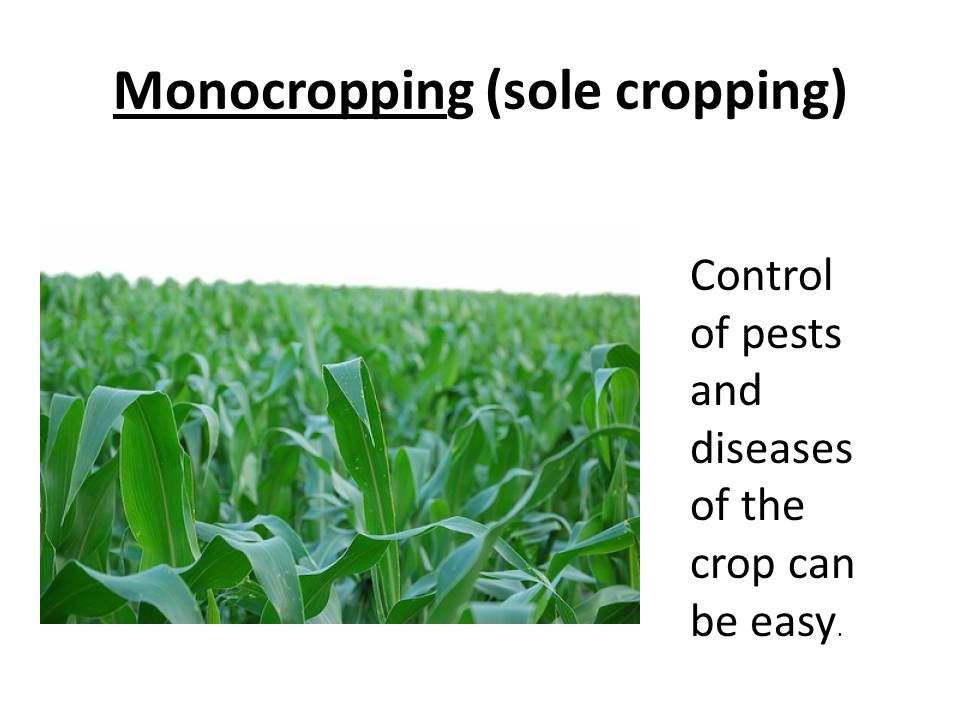
Advantages:
a. Machines can be used to do farm operations.
b. It leads to specialization among farmers for particular crops.
c. Chemicals can be used to control weeds.
Disadvantages:
a. It is risky because only one crop could fail as a result of pests and diseases infestation
b. There is rapid spread of pests and diseases.
c. Labour may not be efficiently utilized throughout the year.
d. Farmer can only get only one type of crop.
MIXED CROPPING: It involves the planting of many crops of different type in the same piece of land. For instance, a farmer who plants maize, cassava, okra, plantain, yam, pepper,and sugarcane is said to be practicing mixed cropping system.
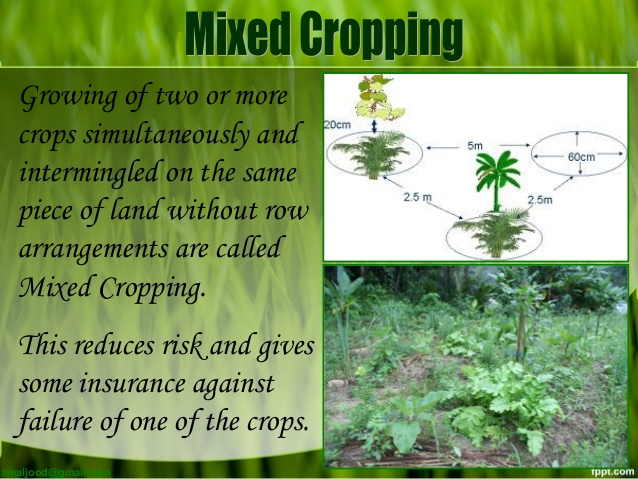
Under mixed cropping, the farmer practice any of the of the following.
(i) INTERPLANTING: The growing of two types of crops on the same piece of land such that the crop planted first is also harvested first before the other. An example is the growing of maize and yam together on same piece of land. The maize which is usually planted first is also harvested first.
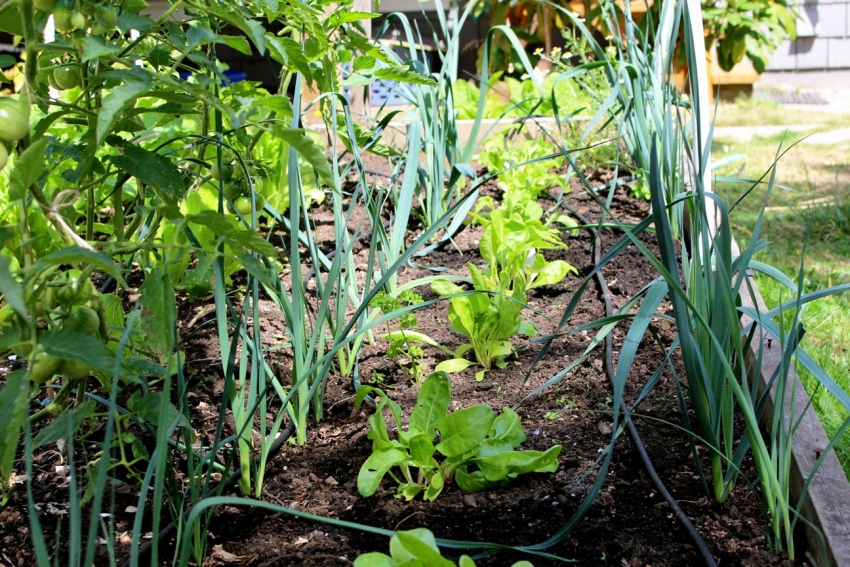
(ii) INTERCROPPING: The growing of two types of crops on the same land such that the crop planted last is harvested first. Example is the planting of melon on the land after yam has been planted. The melon which was planted last is usually harvested first because it takes a shorter period.
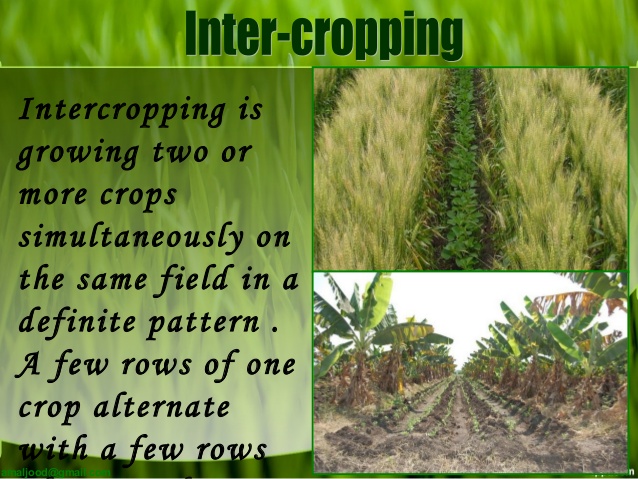
Advantages:
a. Many crops are harvested from the farm.
b. If one of the crops fails, the farmer will gain from others.
c. The spread of pests and diseases is minimized
d. Soil nutrients is efficiently utilized
e. Labour is efficiently utilized throughout the year.
Disadvantages:
a. It does not encourage the use of farm machines.
b. It is labour intensive.
c. Pests and diseases may persist on the farmland
d. It may lead to rapid exhaustion of soil nutrients.
LESSON 10
CONTINUOUS CROPPING: It is the practice of growing the same crop on a piece of land year after year. It is practiced in densely populated area where farmland is scarce.
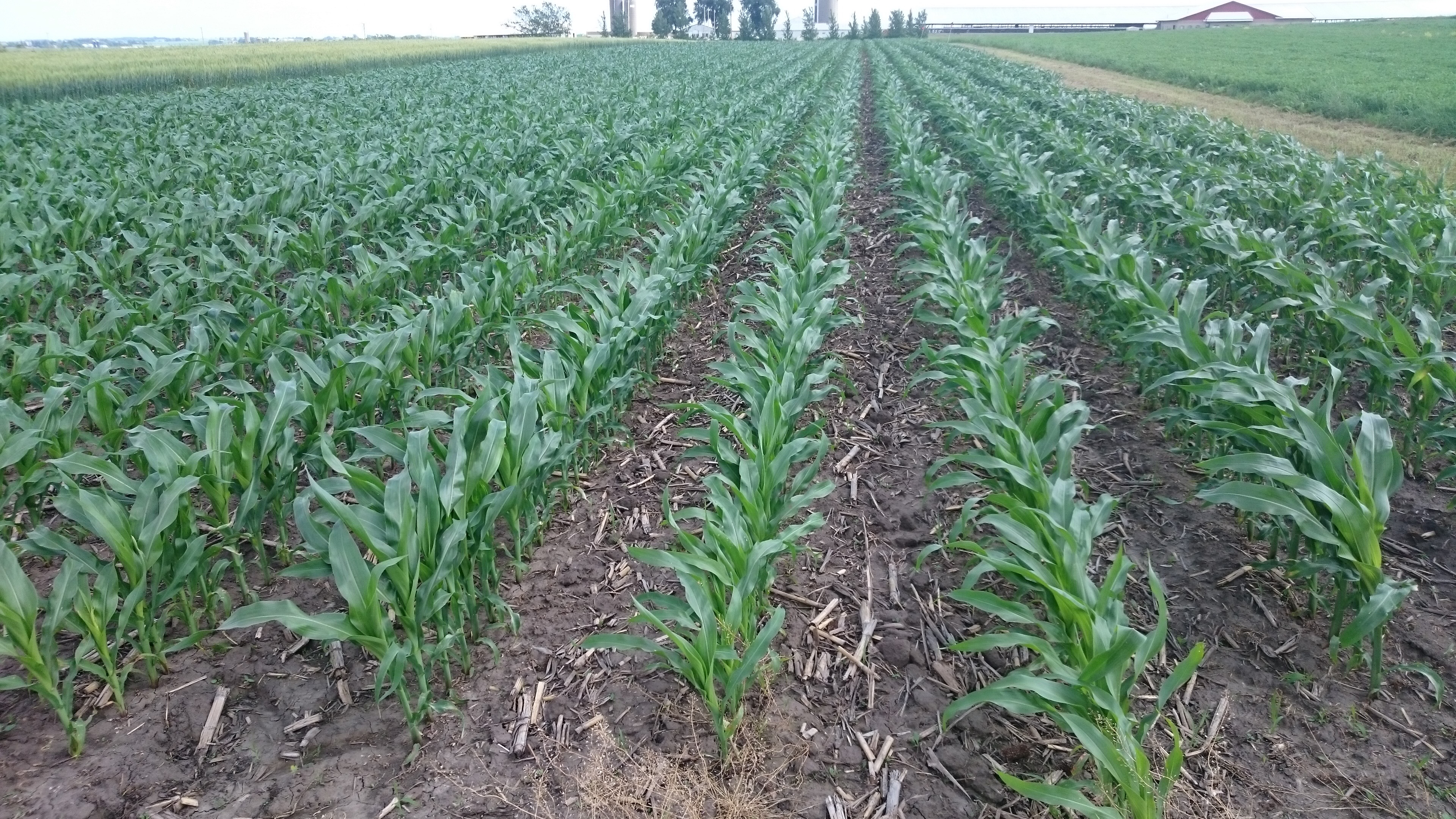
Advantages:
a. It saves time, energy and money.
b. It can practiced where population is high.
c. Machines and chemicals can be used for farming.
d. It leads to specialization of farmer on the crops he deals with.
Disadvantages:
a. It encourages the built up of pests and diseases.
b. It may lead to total failure if the crop is attack by pests or diseases.
c. The soil is often expose to agents of erosion
Crop Rotation: It is a modern system whereby different crops are planted in
various portions of land and they are rotated yearly in definite order .
Principles That Guide Crop Rotation System.
(i) deep rooted crop should follow shallow rooted crops.
(ii) crops that are affected by the same diseases or pests should not follow each other
(iii) Crops that are of the same family e.g maize and rice should not follow each other
(iv) Leguminous crops e.g cowpea or groundnut should be included in the rotation. They fix nitrogen into the soil and also act as cover crops
The table below shows a 4-year-crop rotation system.
PLOT/YEAR Plot A Plot B Plot C Plot D
1st year Yam maize Cassava Cowpea
2nd year Maize Cassava Cowpea Yam
3rd year Cassava Cowpea Yam maize
4th year Cowpea Yam maize cassava

Advantages:
a. Soil nutrients is efficiently utilized.
b. Labour is efficiently utilized
c. Many crops are harvested by the farmers.
d. The spread of diseases and pests is minimized
e. It is a good practice where land is scarce
f. It helps to check erosion
Disadvantages:
a. it may lead to the depletion of soil nutrients.
b. It is capital and labour intensive
c. It leads to destruction of soil structure.
EVALUATION:
1. Name 4 types of cropping systems.
2. Explain Inter-planting and Inter-cropping
3. State 3 principles that guide crop rotation system
4. Select 4 crops of your own and design a crop rotation system
REFERENCE TEXTS: -Essentials of Agricultural sc. By Earnest ChukwudiAni
-Junior Sec. Agric. For Nigerian Schs. By Athony Youdeowei
-Prescribed Agric. Sc. For JSS. By Omoruyi S.A. et al
-New Intensive Agric.Sc.For UBE. By E.U. Okaro
TOPIC: CROPPING SYSTEMS.
Contents: Definition of cropping systems.
-Types of cropping systems.
-Advantages and disadvantages of cropping systems.
Definition : Cropping systems refers to the various ways or systems by which crops are grown on the farm land by the farmers. The crops could be grown singly or mixed together in the farm land.
TYPES OF CROPPING SYSTEMS:
1. Mono-cropping (sole cropping)
2. Mixed-cropping
3. Continuous cropping
4. Crop rotation
MONO-CROPPING(SOLE CROPPING): In this system, only one type of crops is planted on a piece of land. For instance, a famer who plants only rice on his farmland is practicing mono-cropping.

Advantages:
a. Machines can be used to do farm operations.
b. It leads to specialization among farmers for particular crops.
c. Chemicals can be used to control weeds.
Disadvantages:
a. It is risky because only one crop could fail as a result of pests and diseases infestation
b. There is rapid spread of pests and diseases.
c. Labour may not be efficiently utilized throughout the year.
d. Farmer can only get only one type of crop.
MIXED CROPPING: It involves the planting of many crops of different type in the same piece of land. For instance, a farmer who plants maize, cassava, okra, plantain, yam, pepper,and sugarcane is said to be practicing mixed cropping system.

Under mixed cropping, the farmer practice any of the of the following.
(i) INTERPLANTING: The growing of two types of crops on the same piece of land such that the crop planted first is also harvested first before the other. An example is the growing of maize and yam together on same piece of land. The maize which is usually planted first is also harvested first.

(ii) INTERCROPPING: The growing of two types of crops on the same land such that the crop planted last is harvested first. Example is the planting of melon on the land after yam has been planted. The melon which was planted last is usually harvested first because it takes a shorter period.

Advantages:
a. Many crops are harvested from the farm.
b. If one of the crops fails, the farmer will gain from others.
c. The spread of pests and diseases is minimized
d. Soil nutrients is efficiently utilized
e. Labour is efficiently utilized throughout the year.
Disadvantages:
a. It does not encourage the use of farm machines.
b. It is labour intensive.
c. Pests and diseases may persist on the farmland
d. It may lead to rapid exhaustion of soil nutrients.
LESSON 10
CONTINUOUS CROPPING: It is the practice of growing the same crop on a piece of land year after year. It is practiced in densely populated area where farmland is scarce.

Advantages:
a. It saves time, energy and money.
b. It can practiced where population is high.
c. Machines and chemicals can be used for farming.
d. It leads to specialization of farmer on the crops he deals with.
Disadvantages:
a. It encourages the built up of pests and diseases.
b. It may lead to total failure if the crop is attack by pests or diseases.
c. The soil is often expose to agents of erosion
Crop Rotation: It is a modern system whereby different crops are planted in
various portions of land and they are rotated yearly in definite order .
Principles That Guide Crop Rotation System.
(i) deep rooted crop should follow shallow rooted crops.
(ii) crops that are affected by the same diseases or pests should not follow each other
(iii) Crops that are of the same family e.g maize and rice should not follow each other
(iv) Leguminous crops e.g cowpea or groundnut should be included in the rotation. They fix nitrogen into the soil and also act as cover crops
The table below shows a 4-year-crop rotation system.
PLOT/YEAR Plot A Plot B Plot C Plot D
1st year Yam maize Cassava Cowpea
2nd year Maize Cassava Cowpea Yam
3rd year Cassava Cowpea Yam maize
4th year Cowpea Yam maize cassava

Advantages:
a. Soil nutrients is efficiently utilized.
b. Labour is efficiently utilized
c. Many crops are harvested by the farmers.
d. The spread of diseases and pests is minimized
e. It is a good practice where land is scarce
f. It helps to check erosion
Disadvantages:
a. it may lead to the depletion of soil nutrients.
b. It is capital and labour intensive
c. It leads to destruction of soil structure.
EVALUATION:
1. Name 4 types of cropping systems.
2. Explain Inter-planting and Inter-cropping
3. State 3 principles that guide crop rotation system
4. Select 4 crops of your own and design a crop rotation system
REFERENCE TEXTS: -Essentials of Agricultural sc. By Earnest ChukwudiAni
-Junior Sec. Agric. For Nigerian Schs. By Athony Youdeowei
-Prescribed Agric. Sc. For JSS. By Omoruyi S.A. et al
-New Intensive Agric.Sc.For UBE. By E.U. Okaro
WEEK 7
LESSON 12
TOPIC: FISHERY
CONTENT: a. Meaning of Fishery
b. Classification of fish.
a. Meaning and examples of aquatic c animals.
Fishery refers to management and production of fish and other aquatic animals. Of all animals living in water, fish is the most plentiful of them Fish belongs to the group of aquatic vertebrates i.e. .they have back bones .They are specially adapted to live, raised and reproduced in water. The shape of their body enables them to move easily in water ; swim bladder helps them to maintain their balance while the gills are used for respiration. All aquatic animals are found in water bodies such as lakes ,ponds ,streams ,rivers ,oceans ,lagoons and swamps .Other aquatic animals includes whales, dolphins, shrimps, lobster , hippopotamus e.t.c. Examples of fish are :cat fish, mud fish, Nile perch, rays, shark, mackerel, carps, tilapia, croackere.t.c.

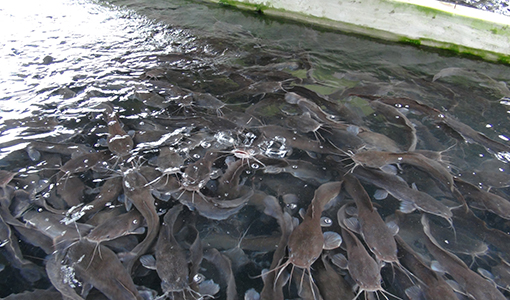
EVALUATION.
• Define fishery.
• What are aquatic animals ?
• Mention five aquatic animals you know.
LESSON 13
Classification of fish.
Fish can be classified into two based on (I) Habitat and (II) Morphology (structure ).

CLASSIFICATION BASED ON HABITAT.
A .Fresh water fish: These are fish that can successfully live and reproduce only in salt free water such as ponds ,lakes, streams, rivers, swamps e.t.c. Examples of fresh water fish are tilapia, cat fish, Nile perch, mud fish, moon fish e.t.c.
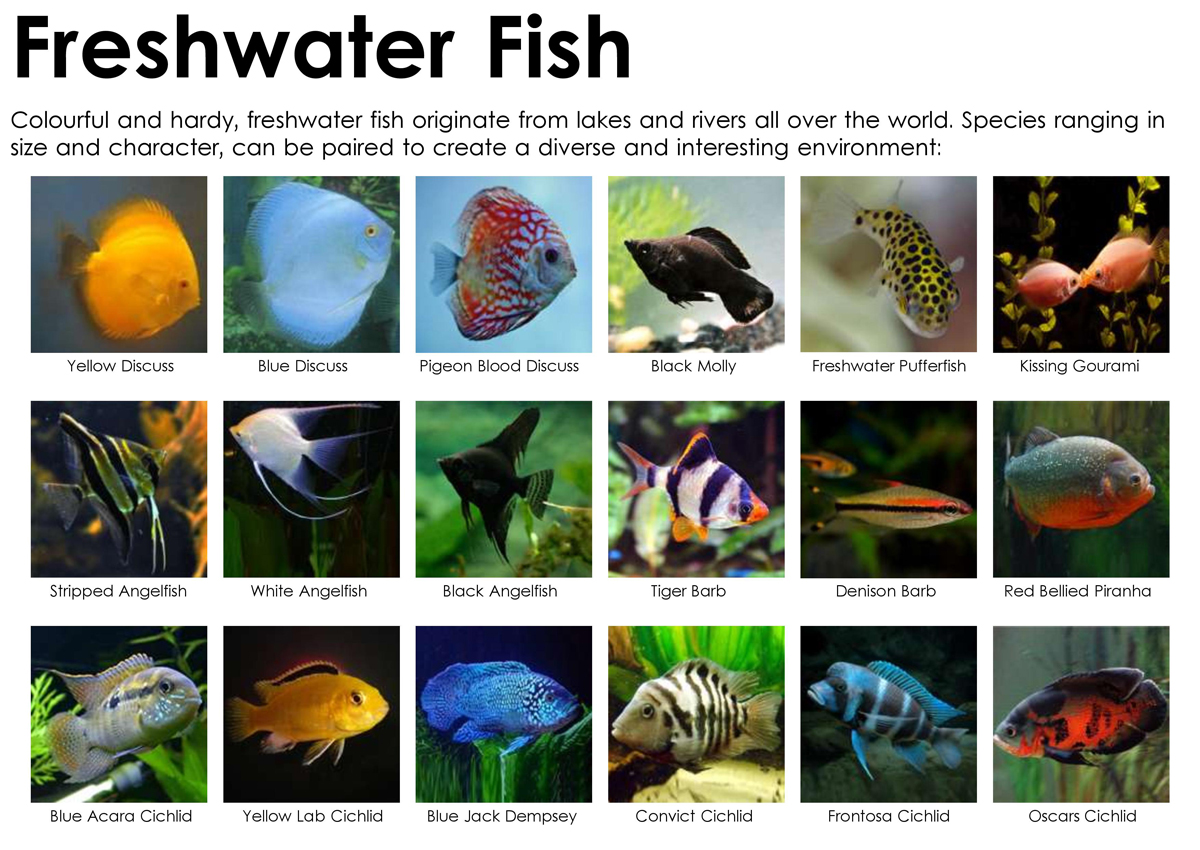
B .Salt water fish :These are fish which can live and reproduce successfully in saline (salt) water like lagoons, oceans, and seas. Examples are :dog fish, shark , croaker, sole, mackerel e.t.c.
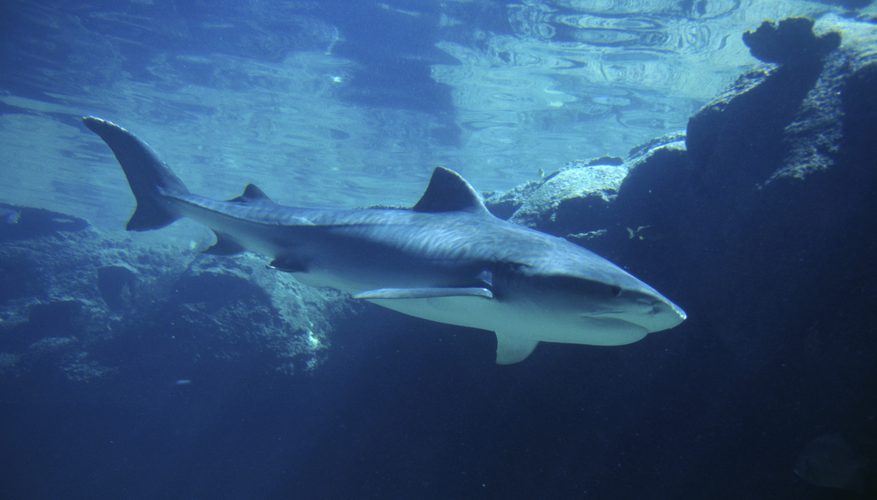
CLASSIFICATION BASED ON MORPHOLOGY
A .Bony fish: These are fish that have the structure of their body made up of bones e.g. tilapia, carps, cat fish, croaker, mackerel etc:
B .Cartilaginous fish :These are fish which have the structure of their body made up of cartilage e.g. dog fish, rays, shark, etc.
EVALUATION:
1.State the two bases of classifying fish.
2.mention four examples each of (I)bony fish and (II) cartilaginous fish .
3.What is the difference between fresh water fish and salt water fish ?
4.State three examples each of fresh water fish and salt water fish
ASSIGNMENT:
State seven uses o f fish and other aquatic animals.
REFERENCES:
1.JSS Agriculture for Nigerian schools by Anthony et al.
2.Essentials of Agriculture for JSS by Anie ..
TOPIC: FISHERY
CONTENT: a. Meaning of Fishery
b. Classification of fish.
a. Meaning and examples of aquatic c animals.
Fishery refers to management and production of fish and other aquatic animals. Of all animals living in water, fish is the most plentiful of them Fish belongs to the group of aquatic vertebrates i.e. .they have back bones .They are specially adapted to live, raised and reproduced in water. The shape of their body enables them to move easily in water ; swim bladder helps them to maintain their balance while the gills are used for respiration. All aquatic animals are found in water bodies such as lakes ,ponds ,streams ,rivers ,oceans ,lagoons and swamps .Other aquatic animals includes whales, dolphins, shrimps, lobster , hippopotamus e.t.c. Examples of fish are :cat fish, mud fish, Nile perch, rays, shark, mackerel, carps, tilapia, croackere.t.c.


EVALUATION.
• Define fishery.
• What are aquatic animals ?
• Mention five aquatic animals you know.
LESSON 13
Classification of fish.
Fish can be classified into two based on (I) Habitat and (II) Morphology (structure ).

CLASSIFICATION BASED ON HABITAT.
A .Fresh water fish: These are fish that can successfully live and reproduce only in salt free water such as ponds ,lakes, streams, rivers, swamps e.t.c. Examples of fresh water fish are tilapia, cat fish, Nile perch, mud fish, moon fish e.t.c.

B .Salt water fish :These are fish which can live and reproduce successfully in saline (salt) water like lagoons, oceans, and seas. Examples are :dog fish, shark , croaker, sole, mackerel e.t.c.

CLASSIFICATION BASED ON MORPHOLOGY
A .Bony fish: These are fish that have the structure of their body made up of bones e.g. tilapia, carps, cat fish, croaker, mackerel etc:
B .Cartilaginous fish :These are fish which have the structure of their body made up of cartilage e.g. dog fish, rays, shark, etc.
EVALUATION:
1.State the two bases of classifying fish.
2.mention four examples each of (I)bony fish and (II) cartilaginous fish .
3.What is the difference between fresh water fish and salt water fish ?
4.State three examples each of fresh water fish and salt water fish
ASSIGNMENT:
State seven uses o f fish and other aquatic animals.
REFERENCES:
1.JSS Agriculture for Nigerian schools by Anthony et al.
2.Essentials of Agriculture for JSS by Anie ..
WEEK 8
LESSON 14
TOPIC : Other aquatic food organisms.
Content: Crustaceans(shell fish), Reptiles, Mammals and Molluscs
Introduction.
There are many other organisms that are living inside water, apart from fish which are used as food by man. These include;
i. Crustaceans(shell fish):Such as prawns, shrimps, cray-fish, lobsters and crabs.
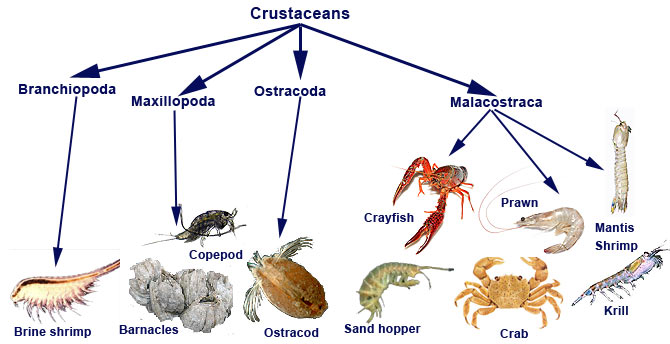
ii. Reptiles: Such as river snake, turtles, crocodiles.
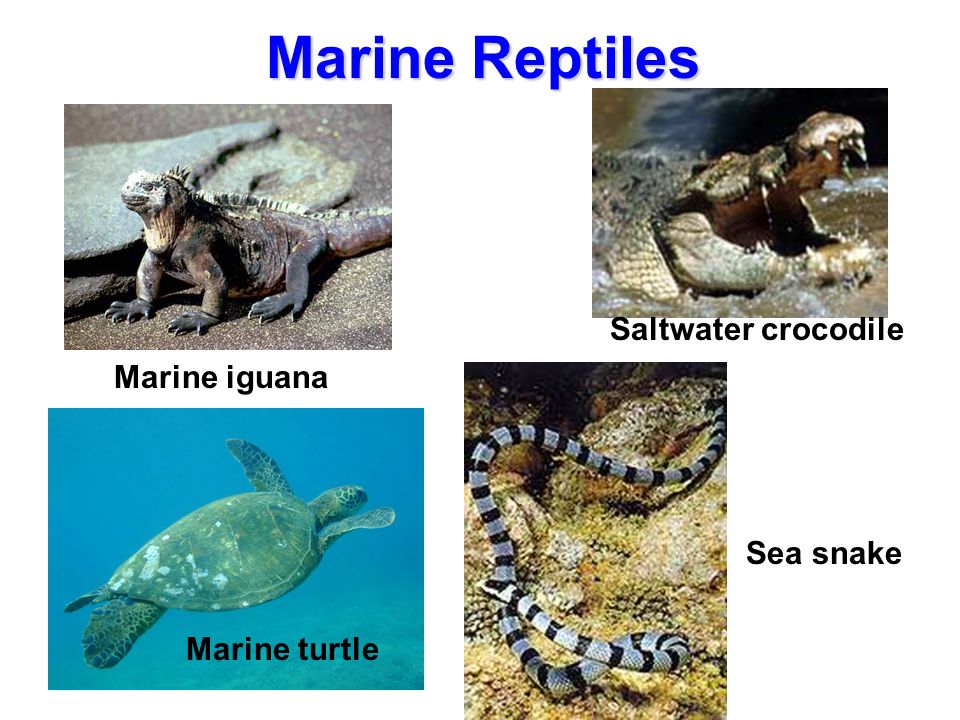
iii. Mammals: Such whales, Hippopotamus, dolphins, seals and porpoises.

iv. Molluscs (Snails): Such as river snails, periwinkle, oyster, squid, clam and octopus
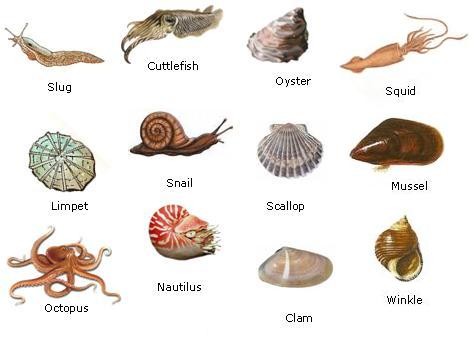
Evaluation:
a. What are aquatic organisms?
b. Give two examples each of the following:
i. Reptiles
ii. Molluscs
iii. Crustaceans
LESSON 15
TOPIC :Uses of fish, methods of fishing , processing and preservation of fish.
Sub Topic 1a .Examples of fish, b. Fish products. c. their uses
Sub topic 2 a. Methods of fishing, b. Fishing equipment .
Sub topic 3 Fishing processing and preservation.
a .Examples of fish, b. Fish products, c. uses .
Examples of fish are : tilapia, cat fish, carp, shark, mud fish, croaker, mackerel, dog fish, Nile perch, etc.
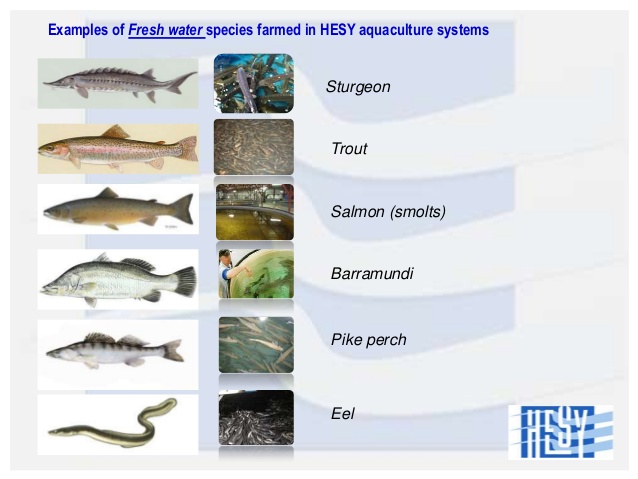
Fish products includes : scales, fish skin, oil, bones ,etc. Other aquatic food organisms include the following whale, shrimps, seals, oyster, periwinkle, etc
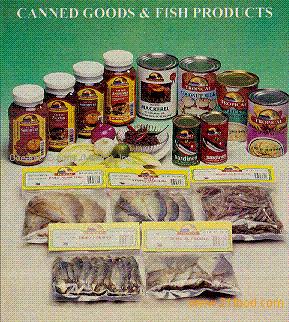
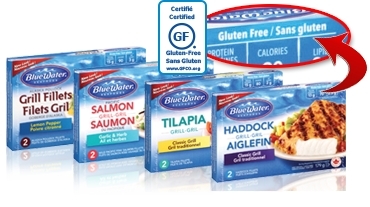
b): Uses of fish, fish products and other aquatic food organisms.
Fish is high in demand for health today because of low cholesterol (unsaturated fat ) content. Fish and other aquatic food organisms are important source of animal proteins, minerals and vitamins essential for normal growth and development of the body. These are :
(I )They are sources of food.
(II )The skin of some aquatic organisms e.g. shark, whale etc. are used as fine leather for making bags shoes belts etc
(III )Fish production provides raw materials for industries .
(IV) Fishery provides employment opportunity for many people.
(V )Fish and its parts may be processed into fish meal which is an essential ingredient in most animal feeds
(VI) The shell of oyster and periwinkle are used for decorating the walls of some buildings.
(VII) Unlike pork, beef, mutton and chevon, fish has no cultural or religious barriers.
(VIII) Some fish (coloured fish ) are used for aesthetic (beautification ) purpose in homes .
(IX) The bones of fish can be crushed and processed into fertilizers.
(X) Fish ponds can provide entertainment as well as instructional facility for students of agriculture and fishery.
(XI) Fish and other aquatic food organisms are taken today by many because of low cholesterol level which help in reducing high Bp and obesity.

EVALUATION:
• State three products of fish .
• Mention five other aquatic food organisms.
1.State four products of fish that are of economic importance .
2 .List five uses of fish and other aquatic food organisms
TOPIC : Other aquatic food organisms.
Content: Crustaceans(shell fish), Reptiles, Mammals and Molluscs
Introduction.
There are many other organisms that are living inside water, apart from fish which are used as food by man. These include;
i. Crustaceans(shell fish):Such as prawns, shrimps, cray-fish, lobsters and crabs.

ii. Reptiles: Such as river snake, turtles, crocodiles.

iii. Mammals: Such whales, Hippopotamus, dolphins, seals and porpoises.

iv. Molluscs (Snails): Such as river snails, periwinkle, oyster, squid, clam and octopus

Evaluation:
a. What are aquatic organisms?
b. Give two examples each of the following:
i. Reptiles
ii. Molluscs
iii. Crustaceans
LESSON 15
TOPIC :Uses of fish, methods of fishing , processing and preservation of fish.
Sub Topic 1a .Examples of fish, b. Fish products. c. their uses
Sub topic 2 a. Methods of fishing, b. Fishing equipment .
Sub topic 3 Fishing processing and preservation.
a .Examples of fish, b. Fish products, c. uses .
Examples of fish are : tilapia, cat fish, carp, shark, mud fish, croaker, mackerel, dog fish, Nile perch, etc.

Fish products includes : scales, fish skin, oil, bones ,etc. Other aquatic food organisms include the following whale, shrimps, seals, oyster, periwinkle, etc


b): Uses of fish, fish products and other aquatic food organisms.
Fish is high in demand for health today because of low cholesterol (unsaturated fat ) content. Fish and other aquatic food organisms are important source of animal proteins, minerals and vitamins essential for normal growth and development of the body. These are :
(I )They are sources of food.
(II )The skin of some aquatic organisms e.g. shark, whale etc. are used as fine leather for making bags shoes belts etc
(III )Fish production provides raw materials for industries .
(IV) Fishery provides employment opportunity for many people.
(V )Fish and its parts may be processed into fish meal which is an essential ingredient in most animal feeds
(VI) The shell of oyster and periwinkle are used for decorating the walls of some buildings.
(VII) Unlike pork, beef, mutton and chevon, fish has no cultural or religious barriers.
(VIII) Some fish (coloured fish ) are used for aesthetic (beautification ) purpose in homes .
(IX) The bones of fish can be crushed and processed into fertilizers.
(X) Fish ponds can provide entertainment as well as instructional facility for students of agriculture and fishery.
(XI) Fish and other aquatic food organisms are taken today by many because of low cholesterol level which help in reducing high Bp and obesity.

EVALUATION:
• State three products of fish .
• Mention five other aquatic food organisms.
1.State four products of fish that are of economic importance .
2 .List five uses of fish and other aquatic food organisms
WEEK 9
LESSON 16
a. Methods of fishing, b. Fishing equipment .
INTRODUCTION: There are THREE major systems of fisheries in Nigeria .These are:
• small scale fisheries
• large scale fisheries(industrial fisheries)
• aquaculture.
i. Small scale fisheries : This is commonly practice by local fishermen who live in fishing camps along the banks of the rivers, ponds or streams or along the coast of the sea.Small scale fisheries is very important because between 50-90% of all the fish consumed in the country come from it. Some of the features of small scale fisheries includes:
_the fisher folks use simple equipment.
_they catch the fish by simple methods
_they catch small quantity of fish.

ii. Large scale / industrial fishery: This practice involve catching fish using large boat called TRAWLERS from natural water bodies. It is carried out on large inland rivers lakes and in the oceans.
Large scale fisheries has the following features:
_it involve the use of complicated and expensive equipment
_it is expensive to set up and operate
_it is carried out in the sea/ocean or in very large inland lake.
_a large quantity of aquatic animals are caught
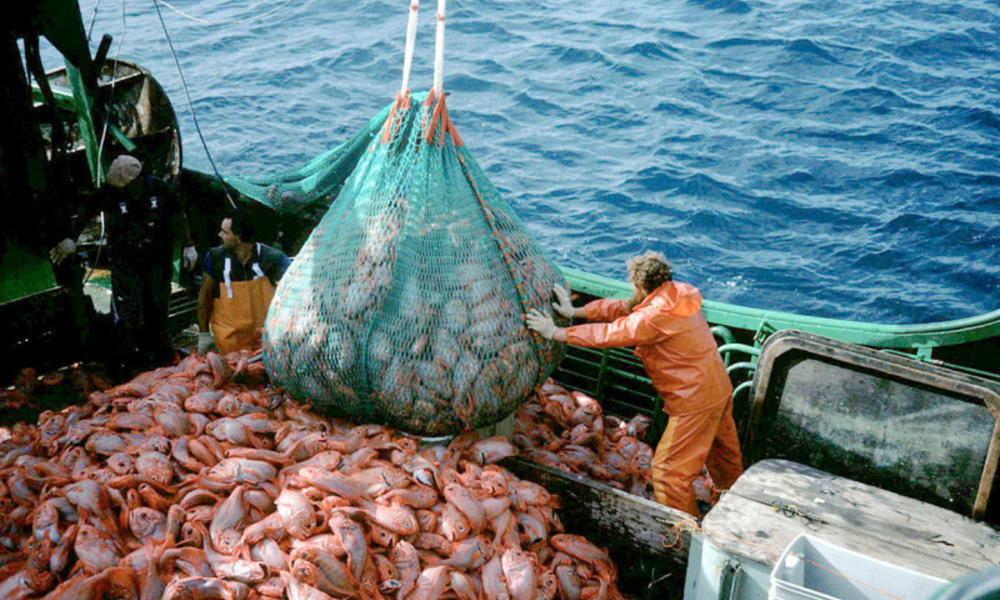
iii. Aquaculture :This is otherwise known as fish farming . It is the practice of rearing fish and other aquatic organisms in artificial water bodies known as fish ponds. Aquaculture majorly produce fish in large quantity for eating and also produces beautiful coloured fish for home aquaria.
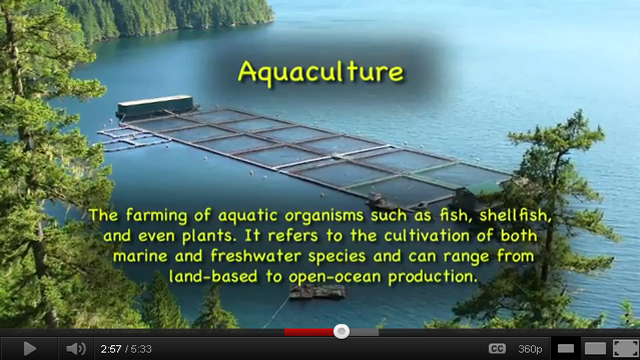
Evaluation
• mention the three major method of fishing in Nigeria?
• State three feature of small scale fishing
• Define aquaculture
LESSON 17
Description of fishing tools
The fishermen used different types of fishing in Nigeria. The most common ones among others are Hooks and Lines/ Rod and Line, Nets, Spears (Harpoons), Gourds and Cages.
HOOKS AND LINES: These consist of small curved metals. A hook may be attached to a wooden handle with a line. To attract the fish , the hook(s) are baited with either earthworms, snails, red soap, small fish, melon, etc. Each line has a float which indicates that the hook has been swallowed a fish when it enters the water.
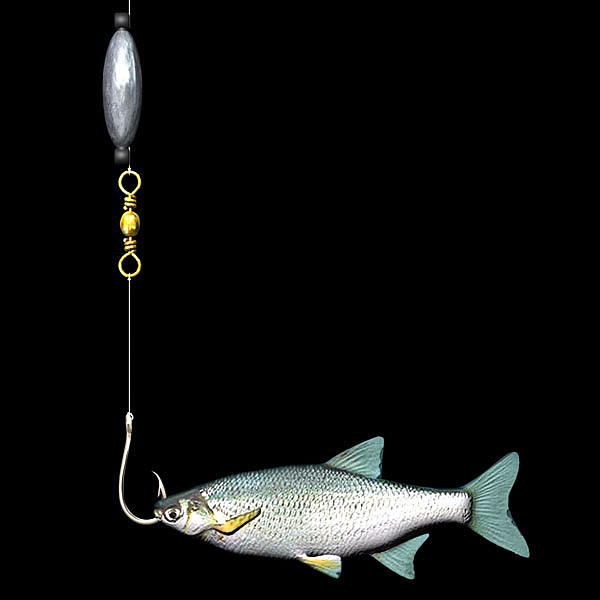
FISHING GOURDS/BASKETS /POTS: Some fishermen when fishing in ponds, stream or shallow lakes use clay pots, baskets or gourds for trapping the fish. Gourds are mostly used in the Northern parts of Nigeria, in Sokoto and in Argungu fishing festival in Kebbi state. Gourd is made of calabash.


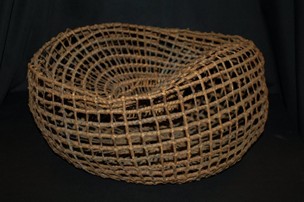
Description of fishing tools-Nets and Spears
FISHING NETS: These consist of fine cotton or nylon threads which are woven to form nets. Small weights of lead are attached to the edges of the nets to help it sink to the bottom of the water when fishing. They are used to trap fish trying to swim across it. Examples of nets are
• Cast and Throw Nets
• Gill Nets
• Seine Nets
• Lift Nets
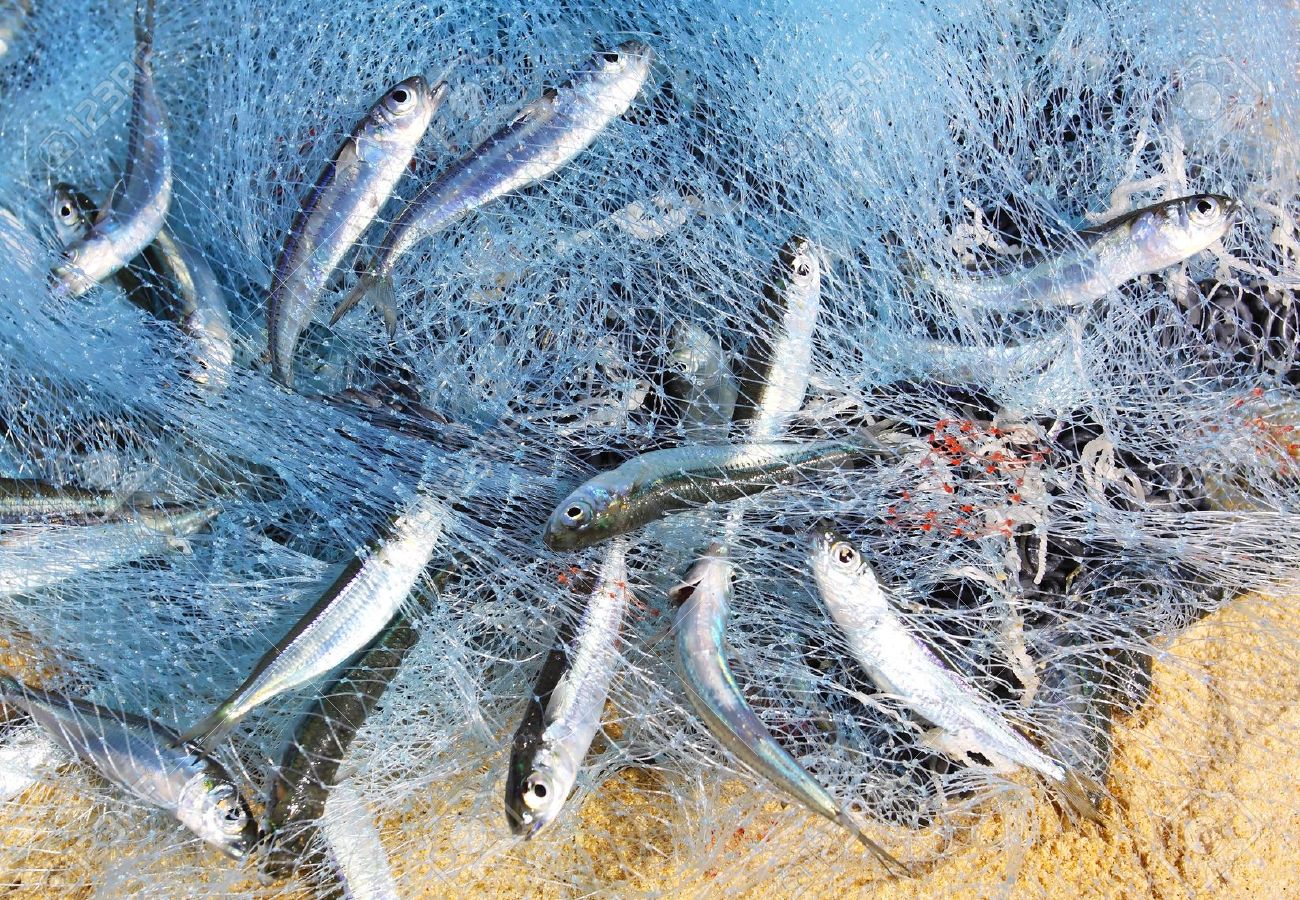
FISHING SPEARS: A fishing spear or harpoon is made of metal prongs fitted into a wooden handle. The spear may have one, two or more prongs which are very sharp and pointed. It is a throwing weapon used in hunting large fish and sea animals.

FISHING CAGES/ TRAPS: These tools may be made of cane, wire netting, or other local materials. They can be made into different shapes but the most common type is the funnel shaped ones. Each cage has a wide opening at one end which allow fish swim into it and a trap door which prevent the fish from going out of the cage.
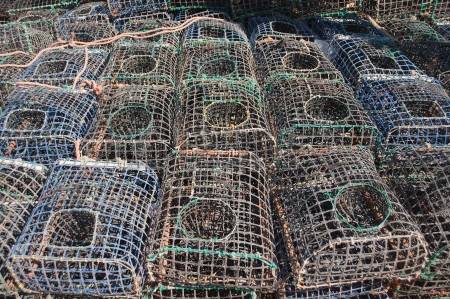
EVALUATION:
• What are fishing tools?
• Describe a gourd and where it is used.
• Outline four types of nets
• How can a fisherman hunt fish using the harpoon?
• List four fishing tools and their uses
• Differentiate between the hook and spear
LESSON 17
Fishing processing and preservation.
INTRODUCTION: Fish and other aquatic animals are highly perishable product, thus they need proper preservation to prevent them from spoilage.
Meaning of preservation of fish: This is the way of taking good care of fish after it has been capture in order to prevent it from getting spoil.
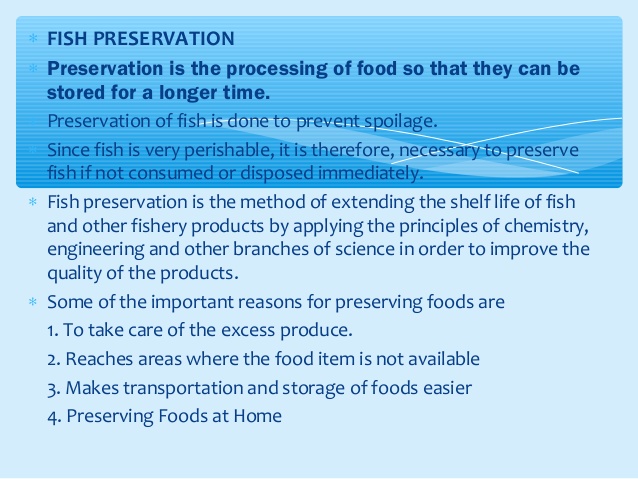

SUN DRYING: This is the most common method of preserving fish. The visceral contents are removed and then dry in sun.
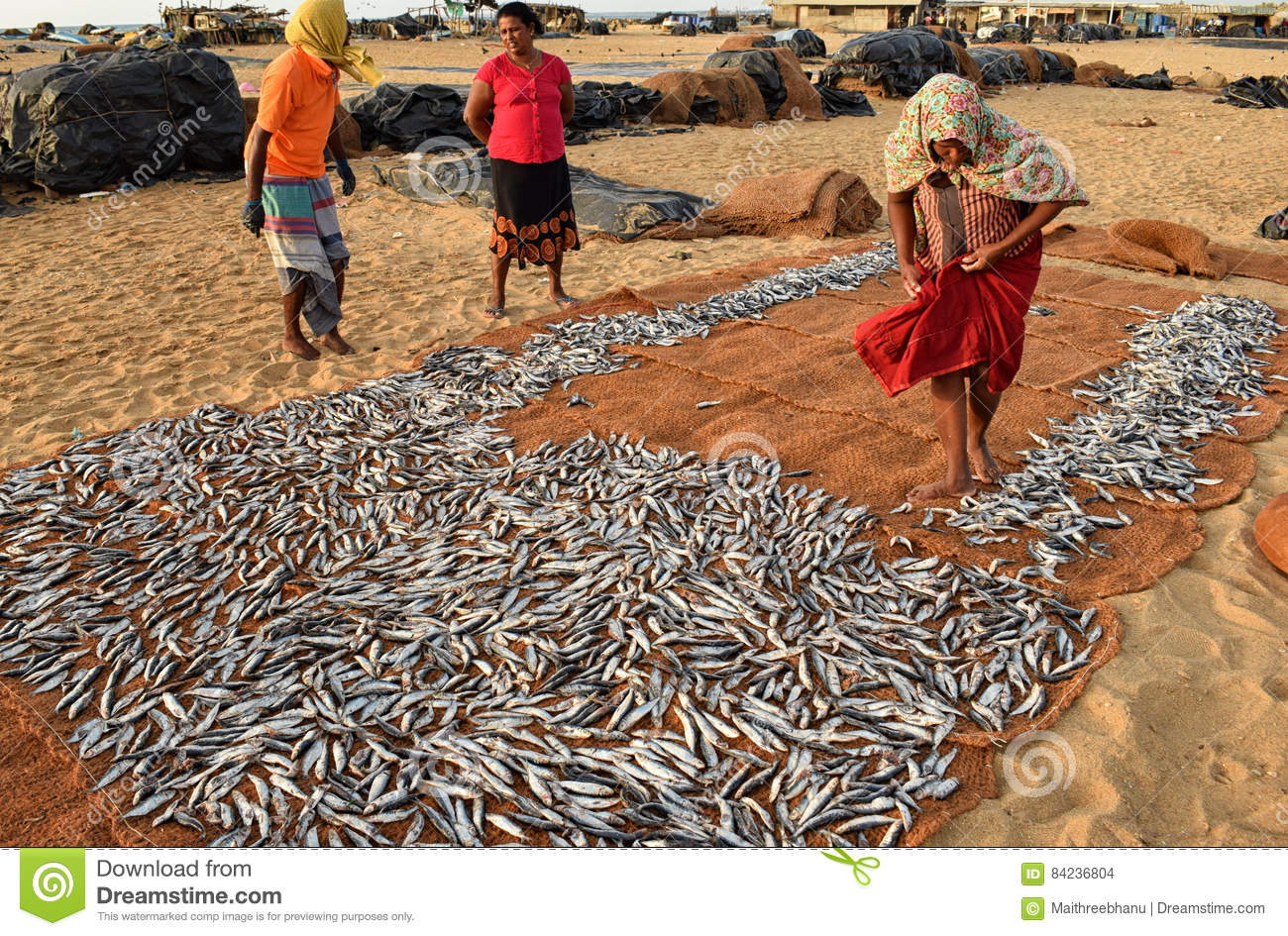
SALTING: It is an old method of preserving fish .It involves rubbing the body of fish with salt and also placed inside the fish through the mouth, gills and in the empty stomach. The fish can also be soaked in a salt water solution before sun dry.
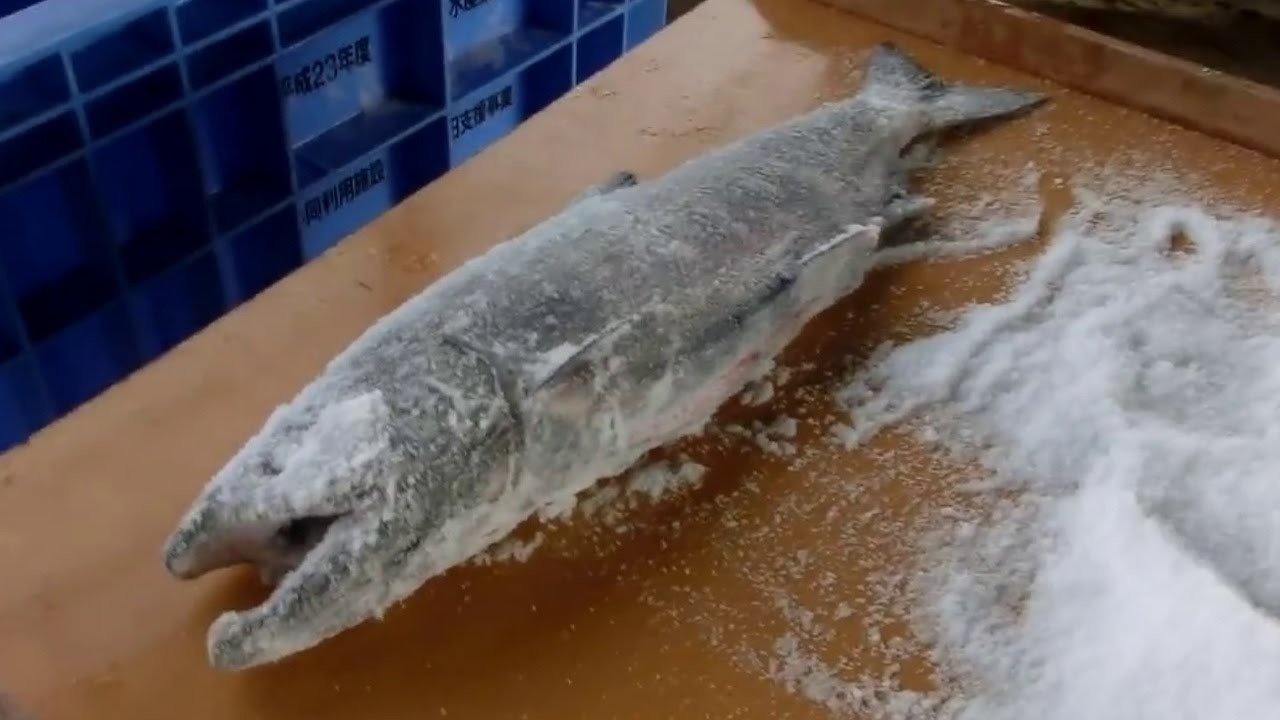
SMOKING: This is another common method of preserving fish .The fish to be smoked are placed on metal guaze tray which are then placed on the open top of a mud oven .The oven has a fire place at the bottom where wood and charcoal are burnt to produce the heat and smoke that preserve the fish.

FREEZING: This is a modern method of preserving fish .It is commonly used in industrial fishery. Fish and other aquatic animals are kept in refrigerator or cold rooms.

CANNING: This is the process of putting fish in tins or cans with special oils or paste which serves as preservatives. An examples of canned fish are sardines Geisha .The factory where fish are processed and put in tins is called a CANNERY.
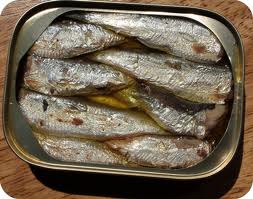
CONVERSION TO FISH MEAL: Some parts of fish which are not good for human consumption and some fish that are too small are dried and grind to make fish meal. This is used in livestock feeds, especially poultry .
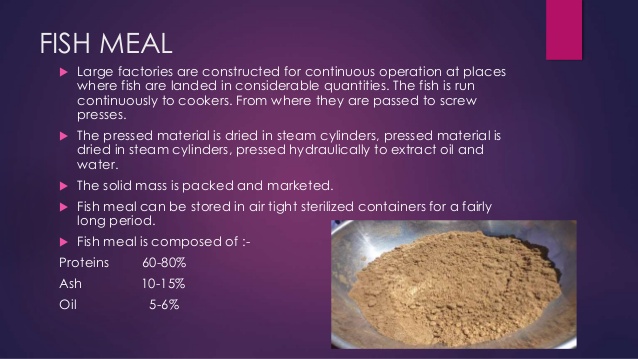
EVALUATION:
1. Why do we need to preserve fish?
2. Methods of preserving fish include the following:
_sun drying
-salting
-smoking
-freezing
-canning
-conversion to fish meal
3. Mention five methods of preserving fish.
4. Briefly explain how to smoke fish
5. The factory where fish are processed and put in tins is called……….
REFERENCE TEXTS
• Junior Secondary Agriculture For Nigerian Schools By Anthony Youdeowei et al
• Intensive Agricultural science For JSS 1-3 By E . U Okaro
• Essentials Of Agricultural Science For JSS And Colleges By Earnest Chukwudi
a. Methods of fishing, b. Fishing equipment .
INTRODUCTION: There are THREE major systems of fisheries in Nigeria .These are:
• small scale fisheries
• large scale fisheries(industrial fisheries)
• aquaculture.
i. Small scale fisheries : This is commonly practice by local fishermen who live in fishing camps along the banks of the rivers, ponds or streams or along the coast of the sea.Small scale fisheries is very important because between 50-90% of all the fish consumed in the country come from it. Some of the features of small scale fisheries includes:
_the fisher folks use simple equipment.
_they catch the fish by simple methods
_they catch small quantity of fish.

ii. Large scale / industrial fishery: This practice involve catching fish using large boat called TRAWLERS from natural water bodies. It is carried out on large inland rivers lakes and in the oceans.
Large scale fisheries has the following features:
_it involve the use of complicated and expensive equipment
_it is expensive to set up and operate
_it is carried out in the sea/ocean or in very large inland lake.
_a large quantity of aquatic animals are caught

iii. Aquaculture :This is otherwise known as fish farming . It is the practice of rearing fish and other aquatic organisms in artificial water bodies known as fish ponds. Aquaculture majorly produce fish in large quantity for eating and also produces beautiful coloured fish for home aquaria.

Evaluation
• mention the three major method of fishing in Nigeria?
• State three feature of small scale fishing
• Define aquaculture
LESSON 17
Description of fishing tools
The fishermen used different types of fishing in Nigeria. The most common ones among others are Hooks and Lines/ Rod and Line, Nets, Spears (Harpoons), Gourds and Cages.
HOOKS AND LINES: These consist of small curved metals. A hook may be attached to a wooden handle with a line. To attract the fish , the hook(s) are baited with either earthworms, snails, red soap, small fish, melon, etc. Each line has a float which indicates that the hook has been swallowed a fish when it enters the water.

FISHING GOURDS/BASKETS /POTS: Some fishermen when fishing in ponds, stream or shallow lakes use clay pots, baskets or gourds for trapping the fish. Gourds are mostly used in the Northern parts of Nigeria, in Sokoto and in Argungu fishing festival in Kebbi state. Gourd is made of calabash.



Description of fishing tools-Nets and Spears
FISHING NETS: These consist of fine cotton or nylon threads which are woven to form nets. Small weights of lead are attached to the edges of the nets to help it sink to the bottom of the water when fishing. They are used to trap fish trying to swim across it. Examples of nets are
• Cast and Throw Nets
• Gill Nets
• Seine Nets
• Lift Nets

FISHING SPEARS: A fishing spear or harpoon is made of metal prongs fitted into a wooden handle. The spear may have one, two or more prongs which are very sharp and pointed. It is a throwing weapon used in hunting large fish and sea animals.

FISHING CAGES/ TRAPS: These tools may be made of cane, wire netting, or other local materials. They can be made into different shapes but the most common type is the funnel shaped ones. Each cage has a wide opening at one end which allow fish swim into it and a trap door which prevent the fish from going out of the cage.

EVALUATION:
• What are fishing tools?
• Describe a gourd and where it is used.
• Outline four types of nets
• How can a fisherman hunt fish using the harpoon?
• List four fishing tools and their uses
• Differentiate between the hook and spear
LESSON 17
Fishing processing and preservation.
INTRODUCTION: Fish and other aquatic animals are highly perishable product, thus they need proper preservation to prevent them from spoilage.
Meaning of preservation of fish: This is the way of taking good care of fish after it has been capture in order to prevent it from getting spoil.


SUN DRYING: This is the most common method of preserving fish. The visceral contents are removed and then dry in sun.

SALTING: It is an old method of preserving fish .It involves rubbing the body of fish with salt and also placed inside the fish through the mouth, gills and in the empty stomach. The fish can also be soaked in a salt water solution before sun dry.

SMOKING: This is another common method of preserving fish .The fish to be smoked are placed on metal guaze tray which are then placed on the open top of a mud oven .The oven has a fire place at the bottom where wood and charcoal are burnt to produce the heat and smoke that preserve the fish.

FREEZING: This is a modern method of preserving fish .It is commonly used in industrial fishery. Fish and other aquatic animals are kept in refrigerator or cold rooms.

CANNING: This is the process of putting fish in tins or cans with special oils or paste which serves as preservatives. An examples of canned fish are sardines Geisha .The factory where fish are processed and put in tins is called a CANNERY.

CONVERSION TO FISH MEAL: Some parts of fish which are not good for human consumption and some fish that are too small are dried and grind to make fish meal. This is used in livestock feeds, especially poultry .

EVALUATION:
1. Why do we need to preserve fish?
2. Methods of preserving fish include the following:
_sun drying
-salting
-smoking
-freezing
-canning
-conversion to fish meal
3. Mention five methods of preserving fish.
4. Briefly explain how to smoke fish
5. The factory where fish are processed and put in tins is called……….
REFERENCE TEXTS
• Junior Secondary Agriculture For Nigerian Schools By Anthony Youdeowei et al
• Intensive Agricultural science For JSS 1-3 By E . U Okaro
• Essentials Of Agricultural Science For JSS And Colleges By Earnest Chukwudi